How to get from Colombia to Ecuador by bus | Full guide from Cali to Quito (2022)

Crossing the Land Border from Colombia to Ecuador
Here it comes! Another border crossing, this time from Colombia to Ecuador. Not that we wouldn’t still have so much to say about Colombia (and some countries before and after, to be honest), but I decided to share this article first in order to keep the information as up-to-date as possible .
We used Rumichaca International Bridge as a crossing point (the one most travelers use) and the whole trip took us just over 20 hours (or about 22 door-to-door). The total costs from Cali to Quito were €21 per person.
To compare, the typical price of a flight ticket from Cali to Quito is currently €146 only with a carryon and the flight takes at least 4 hours (with a layover in Bogotá, a direct flight from Bogotá could be about €90 with a carryon, and would take 2 hours + whatever you need at the airport). When traveling by land, you’re not only saving our planet but also your money.
Travel Itinerary: From Colombia to Ecuador via Rumichaca Bridge
The whole journey with a budget per person:
- Day 1 / 8:00 pm Cali → Ipiales 6:00 am; Basic bus 65.000 COP ≈ €13
- Day 2 / 6:30 am Ipiales → Rumichaca 6:40 am; Colectivo 2.500 COP ≈ €0.50
- Day 2 / 7:40 am Exiting Colombia
- Day 2 / 8:20 am Entering Ecuador
- Day 2 / 8:30 am Rumichaca → Tulcan Bus Terminal 8:45 am; Colectivo $0.75
- Day 2 / 10:00 am Tulcan → Quito 4:15 pm; Basic bus $7.25
Total cost: €21
You’ll find a detailed description of the journey with all the directions and important information in the following paragraphs.
DIY Journey from Cali to Quito by Public Transport
*5.000 COP ≈ $1 ≈ €1
We made this trip in April 2022 and we actually went all the way from Cali to Quito by bus in one go. You can also make another stop along the road and split the trip. Las Lajas Sanctuary is a popular place to visit on the Colombian side and Otovalo town with its huge market on the Ecuadorian.
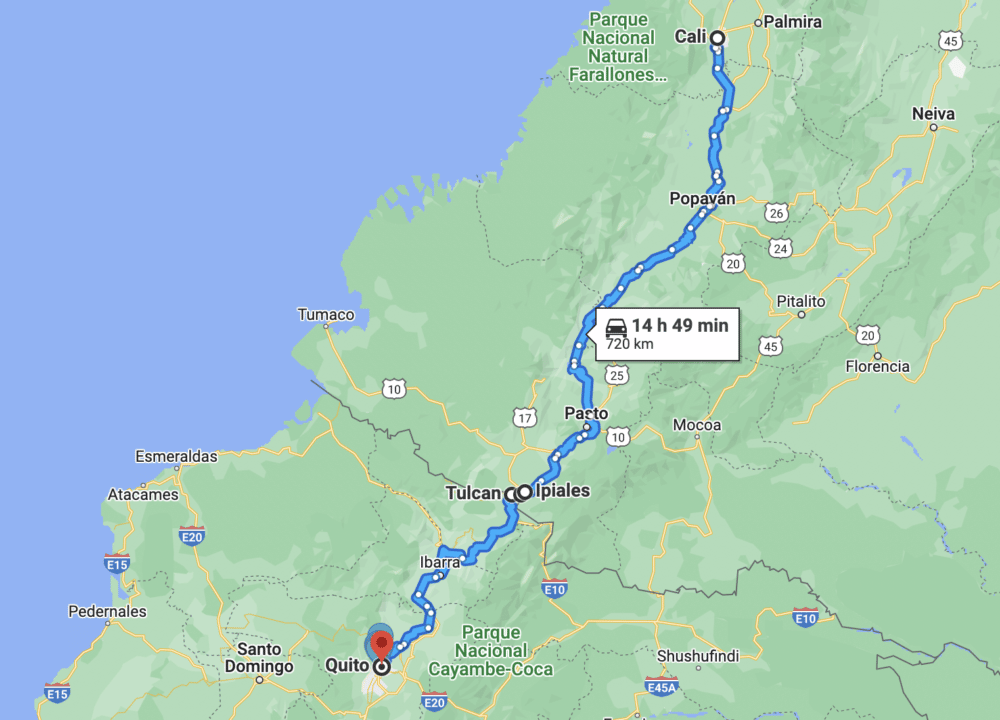
Cali to Ipiales by Bus | Day 1
There are buses going from Cali to Ipiales every hour or two from the bus terminal. You can check the availability and times on redbus , but we were never able to buy the ticket with our Revolut card. It’s not a problem. You just need to go to any bus terminal and buy the ticket at the counter of the company.
We chose an overnight bus at 8 pm from the company Expreso Bolivariano. Unfortunately, there was no double-decker, but you might want to check if you have more luck. The first floor is usually first class, which means bigger and more comfortable seats declining by 160°.
The bus was supposed to get us to Ipiales at 8 am, but it arrived 2 hours earlier. When we got out, it was madness. Everybody was trying to sell us something, offering a ride to the border and whatever else. We wanted to take our time, use the bathroom, etc., so we went to the terminal.
Colectivo from Ipiales to Rumichaca Border | Day 2
Good to know: the bathrooms at the bus terminal in Ipiales are open in the morning. While I was waiting at the terminal, a security guy approached me and told me to only use the official services – a yellow taxi or white colectivo . There are also other people offering the ride, as I mentioned, and with those, apparently, incidents tend to happen.
We listened to the advice and took the official white colectivo. You’ll find the station just behind the terminal building – you can always ask the security guy or the orange taxi drivers. It was 2.500 COP (€0.50) per person, a taxi would be 8.000 COP (€1.60).

Crossing the Border from Colombia to Ecuador at Rumichaca Bridge
We got to Rumichaca at 6:40 am and it took us almost two hours before we entered Ecuador. There was almost no line at the Colombian immigration office this early in the morning. When we wanted to enter the office to get our passport stamped (don’t forget to do that!), we found out we need to have the Check-Mig form filled out.
Check Mig is a document introduced during the pandemic. You need to fill it out 1–24 hours before entering the country and, obviously, before leaving as well.
You can do that at the official government webpage or in the app , but I encourage you not to leave it to the border. The internet connection is really bad there (and if you don’t have data, you’re screwed), it took us an eternity. After that, the process was swift.
When we got our stamp, we wanted to exchange our leftover pesos . There are many people offering that, but make sure you know how much you’re supposed to get. According to the official rate, we were supposed to get $85 for our pesos. The guy was trying to get it for $41, and we got $75 in the end.
Entering Ecuador by Land
The Ecuadorian immigration office at Rumichaca doesn’t open before 8 am . We were actually happy everything took so long on the Colombian side and we didn’t need to wait much longer. Btw. it’s really cold there since it’s about 2.500 masl. And I had shorts.
Anyhow, when they opened, we had our covid vaccine certificate checked first, and went to the immigration office. It took like two minutes to get the stamp and we were in Ecuador. Just like that.
You’re not supposed to pay anything (as an EU citizen) and don’t forget to check the date and how many days did you get.
Now, you need to get another taxi/colectivo from Rumichaca to Tulcan Bus terminal. The taxi/colectivo station is visible from the immigration office and it’s pretty clear which is official and which is not. The colectivo was $0.75, a taxi would be $3.
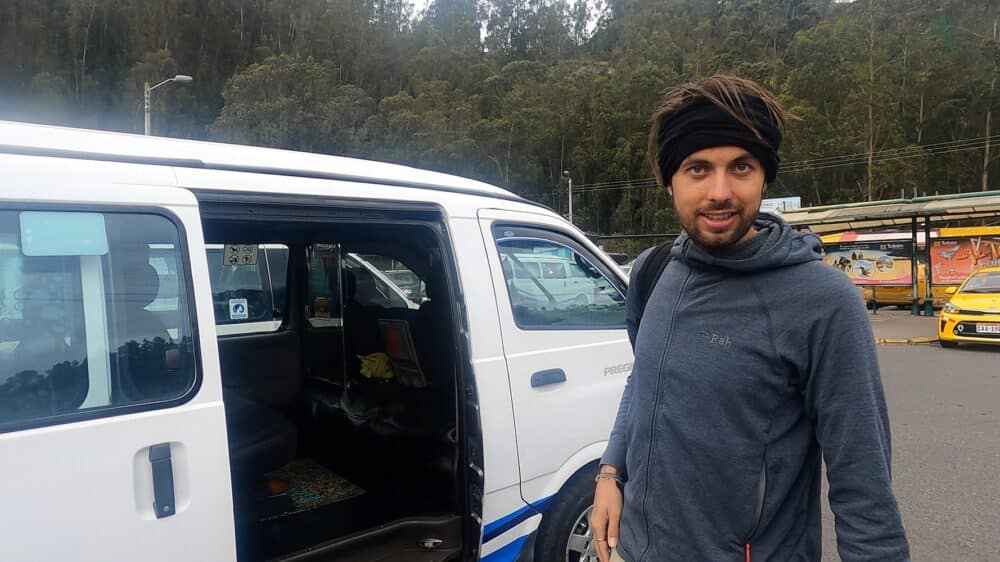
From Tulcan to Quito by Bus (or anywhere else)
You can take a bus from the bus terminal in Tulcan anywhere to the northern part of Ecuador. To be honest, calling it terminal is a bit exaggerated. There were buses from Tulcan to Quito every two hours or so. We picked one at 10 am for $7.25.
It seemed like one of the better ones. You can always make them show you for which bus you’re buying a ticket. Don’t forget you’ll sit in it for at least 6 hours if the traffic is good (or about two hours if you’re only going to Otovalo).
We got to Quito at 4:15 pm and took a trolley bus & two buses to our coliving in Floresta. And that was it! We made it home around 5 pm, almost exactly 22 hours after we left our hostel in Cali.
Final tips for the Trip from Colombia to Ecuador
- Always check on both government’s websites what you need to leave/enter the country – for us, as EU citizens in April 2022, it was: Check-Mig to leave Colombia and a vaccination card with two doses to enter Ecuador (and a passport, of course)
- Since the region close to the border is one of the areas in Colombia where violent strikes happen from time to time, check if the situation is ok at the time when you want to go
- You can exchange your leftover pesos for dollars at the border, but make sure to check the exchange rate before
- You can buy a sim card in Tulcan, with a credit for 3 days, and recharge it later (I think it was for $5)
- The buses in Colombia are usually pretty safe, but we’ve heard this route tends to have more robberies – watch out for your valuables!
- The buses in Ecuador are NOT so safe – we didn’t have any problems during our three months there since we were really careful, but we’ve heard one too many stories about people who got their backpacks cut and valuables stolen – always keep it on your lap, it’s never safe under the seat in Ecuador
- There are options to buy coffee and breakfast near the bus terminal in Tulcan
- The public transport in Cali works well and you can easily take a local bus to the bus terminal – we had a rechargeable card, but noticed later that a Visa card might be enough
- The public transport in Quito works, it’s just not so well organized and the buses usually don’t go after it gets dark; one ride is $0.35 and we felt pretty safe
Like it? Pin it!

Hiking an Active Volcano in Guatemala: Acatenango & Fuego Hike
If there is one thing you shouldn’t miss in Antigua, it’s hiking the Acatenango volcano and admiring the explosions of the active volcano Fuego from close. We did this hike
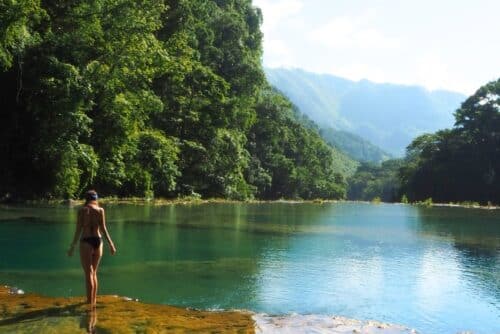
How to Visit Semuc Champey Without A Tour?
Semuc Champey was without a doubt one of the most beautiful places we visited. Not only were the absurdly turquoise natural pools on the river impressive, but also the whole

Tikal: How to Visit without a Tour Guide
Tikal is without a doubt a place you can’t skip when visiting Guatemala. Exploring the ruins hidden in the jungle was definitely an experience of a lifetime that I wouldn’t
Leave a Reply Cancel reply
Your email address will not be published. Required fields are marked *
Winter is here! Check out the winter wonderlands at these 5 amazing winter destinations in Montana
- Travel Tips
Crossing Borders – Colombia To Ecuador Via The Rumichaca Crossing
Published: September 11, 2023
Modified: January 3, 2024
by Minnaminnie Trull
- Central & South America
- Plan Your Trip
- Travel Destinations
Introduction
History of the rumichaca crossing, location and facilities at the rumichaca crossing, requirements and documentation for crossing the border, transportation options for crossing from colombia to ecuador, tips for a smooth border crossing, cultural differences and customs in colombia and ecuador, safety precautions for traveling through the rumichaca crossing.

- Privacy Overview
- Strictly Necessary Cookies
This website uses cookies so that we can provide you with the best user experience possible. Cookie information is stored in your browser and performs functions such as recognising you when you return to our website and helping our team to understand which sections of the website you find most interesting and useful.
Strictly Necessary Cookie should be enabled at all times so that we can save your preferences for cookie settings.
If you disable this cookie, we will not be able to save your preferences. This means that every time you visit this website you will need to enable or disable cookies again.
Ecuador Travel Restrictions
Traveler's COVID-19 vaccination status
Traveling from the United States to Ecuador
Open for vaccinated visitors
COVID-19 testing
Not required
Not required for vaccinated visitors
Restaurants
Not required in public spaces.
Documents & Additional resources
Ready to travel, find flights to ecuador, find stays in ecuador, explore more countries on travel restrictions map, destinations you can travel to now, dominican republic, netherlands, philippines, puerto rico, switzerland, united arab emirates, united kingdom, know when to go.
Sign up for email alerts as countries begin to open - choose the destinations you're interested in so you're in the know.
Can I travel to Ecuador from the United States?
Most visitors from the United States, regardless of vaccination status, can enter Ecuador.
Can I travel to Ecuador if I am vaccinated?
Fully vaccinated visitors from the United States can enter Ecuador without restrictions.
Can I travel to Ecuador without being vaccinated?
Unvaccinated visitors from the United States can enter Ecuador without restrictions.
Do I need a COVID test to enter Ecuador?
Visitors from the United States are not required to present a negative COVID-19 PCR test or antigen result upon entering Ecuador.
Can I travel to Ecuador without quarantine?
Travelers from the United States are not required to quarantine.
Do I need to wear a mask in Ecuador?
Mask usage in Ecuador is not required in public spaces.
Are the restaurants and bars open in Ecuador?
Restaurants in Ecuador are open. Bars in Ecuador are .
We’re sorry, this site is currently experiencing technical difficulties. Please try again in a few moments. Exception: request blocked

Ecuador to Colombia Border Crossing: The Complete Guide (2023)
There are pros and cons to completing the Ecuador to Colombia border crossing by land. The benefit is that you will save a lot of money and see parts of each country that most travelers don’t get to experience (including the remote and stunning Las Lajas Sanctuary in Ipiales, Colombia).
On the downside, the Ecuador to Colombia border crossing is a bit complicated, will take an entire day (plus a couple extra travel days afterward if your end goal is the coffee region, Medellin, or Bogota). And of course, there are safety concerns. This is not the safest land border crossing in South America, although it is not considered dangerous either. You will just need to take certain precautions, which I’ll discuss below.
While traveling in South America, we ultimately decided to embrace the backpacker lifestyle and cross the Ecuador to Colombia border by a combination of buses, walking, and taxis, rather than go the easier (but much more expensive) flight route between Quito, Ecuador and Bogota, Colombia.
In this blog post, I’m sharing everything you need to know about the Ecuador to Colombia border crossing, including the main border crossing locations, safety tips, and a step-by-step guide to the Ipiales border crossing (the one we did, which is safest and most recommended).
NOTE | I completed this border crossing in late September 2022, and have updated this post for 2023. I am doing my best to keep this article updated, but I need your help! If you find this guide useful, please comment below with any changes or updates! Together, we can help future travelers navigate the Ecuador Colombia border safely.
Check out my other border crossing guides…
Ecuador to Colombia Border Crossing Guide
Panama to Costa Rica Border Crossing Guide
Costa Rica to Nicaragua Border Crossing Guide
Nicaragua to El Salvador Border Crossing Guide
El Salvador to Guatemala Border Crossing Guide
Guatemala to Honduras Border Crossing Guide
Honduras to Guatemala Border Crossing Guide
Guatemala to Belize Border Crossing Guide
Belize to Mexico Border Crossing Guide
Peru to Ecuador Border Crossing Guide
Sailing the San Blas Islands to Cross From Colombia to Panama (Coming Soon!)
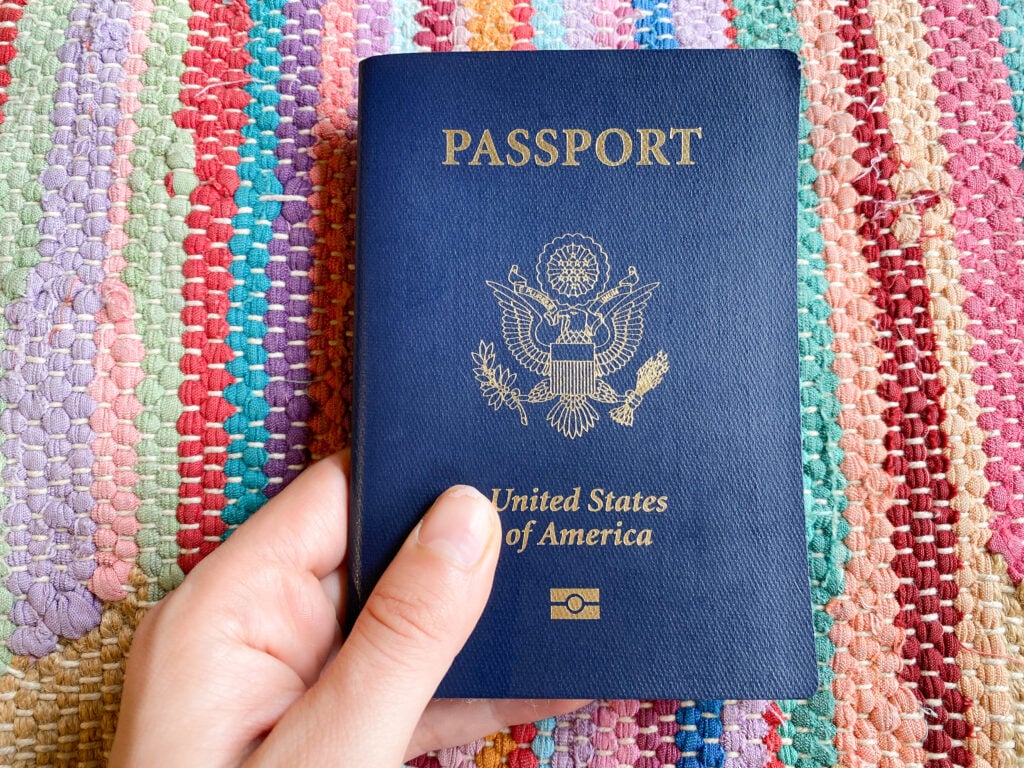
Ecuador to Colombia Border Crossing Locations
There are three main border crossings between Ecuador and Colombia. However, one is extremely dangerous and one is quite remote, leaving only one (the Rumichaca bridge/Ipiales crossing) that you’ll be likely to complete.
The main Ecuador to Colombia border crossing locations are:
- Rumichaca bridge: The most common and safest border crossing from Tulcan, Ecaudor to Ipiales, Colombia. You can easily travel across from Quito in one day.
- San Miguel: The Amazon border crossing, which is not very commonly used but may make sense if you’re visiting the Amazon in Colombia.
- San Lorenzo: The coastal border crossing, which is highly dangerous and not at all safe for travelers.
Because we completed the Rumichaca bridge/Ipiales border crossing between Ecuador and Colombia, and because it’s unlikely you’ll be attempting either of the other two options, the rest of this guide will focus solely on that crossing!
Ecuador to Colombia Border Crossing: Complete Guide
Unlike the Peru to Ecuador border crossing , the Ecuador Colombia border is more like other traditional South America land borders. There is no bus line that can take you directly across the border. This means, you’ll take a combination of buses and taxis to the border, walk on foot across the border, and then take another combination of taxis and buses on the other side.
Don’t worry – I explain all the details below!
How the Ipiales Border Crossing Works
Like I mentioned, this border crossing has quite a few steps and can seem pretty complicated if you’re not keeping track.
In order to complete the Ecuador to Colombia border crossing at Ipiales, you’ll need to follow this route:
- Get to Quito, Ecuador
- Bus from Quito to Tulcan, Ecuador
- Taxi or combi from Tulcan, Ecuador to the Ecuador-Colombia border
- Exit Ecuador and get stamp
- Walk across the Rumichaca bridge (no man’s land)
- Enter Colombia, show MIG form, and get stamp
- Exchange US dollars to Colombian pesos (optional – but recommended)
- Taxi to Ipiales, Colombia
- Onward travel from Ipiales
Before you complete this border crossing, you should also be prepared with some important items or details.
These travel requirements include:
- Completed Check MIG form: This is a form that’s mandatory to enter Colombia. You can have it done for $6 USD on the Ecuador side once you arrive, like we did, but I don’t recommend it (it’s way overpriced and a little stressful). Prepare ahead of time by completing it online . A screenshot of the form on your phone is perfectly acceptable. Update April 2023: A fellow traveler commented below that the check MIG is no longer required for land border crossings! However I couldn’t find any official websites that mentioned this change. Future travelers, please comment any updates below.
- Pre-booked accommodation in Colombia: In order to fill out the MIG form and answer the immigration officers’ questions, you need to provide the address of where you’re staying on your first night in Colombia. Of course, you could make something up, but having accommodation booked also gives you peace of mind. We booked one night at Hotel Royal Class in Ipiales and I highly recommend it – incredible value, clean, and safe.
- Six-months passport validity: It’s always good to have a minimum of six months of passport validity and at least two empty passport pages before you cross any international border. Some countries turn you away without this.
- Check entry requirements: It’s different for every nationality, so check on your government website. Currently, USA and UK citizens can enter Colombia visa-free for 90 days.
- Check health requirements: As you probably know, things are constantly changing regarding COVID-19 travel rules. Currently, you need to show a complete vaccination card, or a negative COVID test. You should check your country’s embassy page for the most reliable information.
Below, I explain all of these steps in detail, as well as our personal experience crossing the Ecuador Colombia border. However, your journey starts before that…
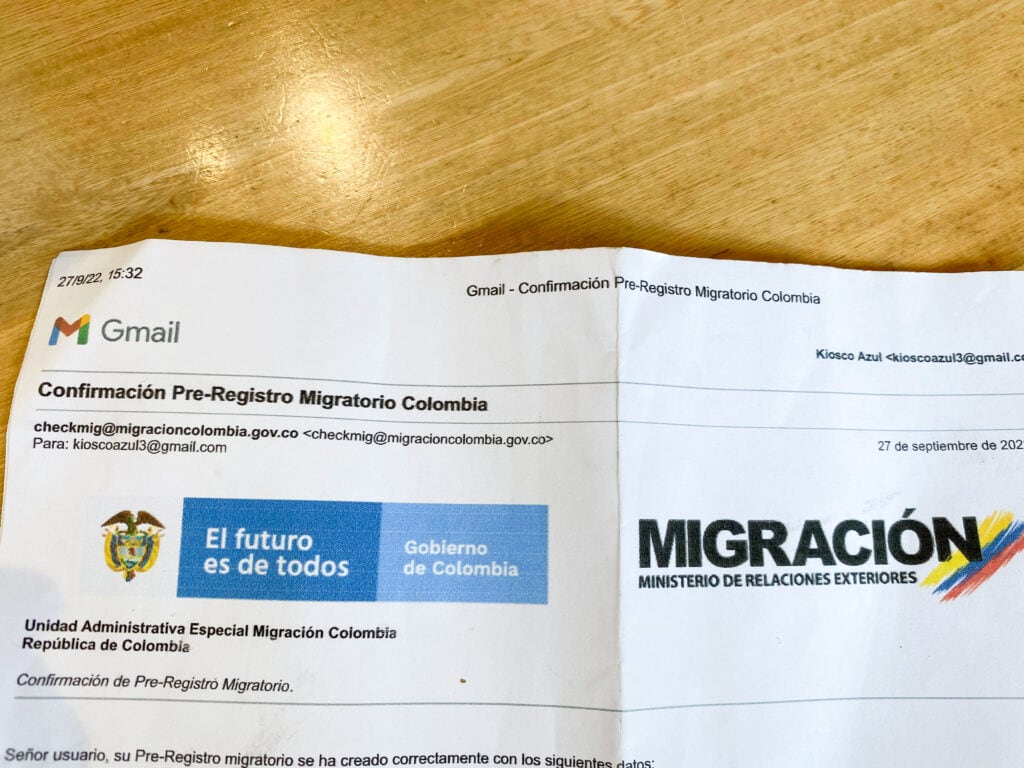
Where to Begin Your Journey in Ecuador
You are probably wondering where in Ecuador you need to begin your journey! There are a few different options but the most convenient place to begin this border crossing is from Quito .
Personally, Dan and I were spending a few days in Mindo, Ecuador (a chocolate lover and waterfall-enthusiast’s dream!). We didn’t really want to go back to Quito just for one night, so we started our journey really early from Mindo.
The first bus from Mindo to Quito is at 6:30am, which meant the earliest bus we could get from Quito-Tulcan was at 9:25am. While everything turned out okay for us, we got lucky with no lines at the border. This border is a major crossing point for Venezuelan refugees, and sometimes you can wait 5+ hours (although this has calmed down recently).
Even without any lines, it was still a long day. If you want to be cautious, and especially if you’re a solo female traveler (more on that later) then I recommend you take an even earlier bus from Quito.
One other option is to begin your journey in Otavalo, Ecuador . Otavalo is a touristy market town situated between Quito and the Ecuador Colombia border. You’ll actually be closer to the border with this option, but you’ll also have to hail the bus coming from Quito and hope they have room to let you on.
Ecuador to Colombia Border Crossing at Ipiales: Step by Step Guide
Dan and I completed the Ecuador to Colombia border crossing in late September 2022. Like I mentioned, we started our journey from Mindo, so this guide will cover all the steps we took from there.
If you’re starting your border crossing from Quito, the below steps will still apply to you, but I recommend beginning the journey with an earlier bus so you have more time at the border before nightfall.
1. Bus from Mindo to Quito, Ecuador
The first step of our long border crossing day was to get to the Mindo bus station. Like a lot of places in Ecuador, there aren’t really addresses per se, in Mindo. To find the bus station, look up “Coop. Flor Del Valle” on Google Maps. The station is on the dirt road that intersects between Av. Quito and Progreso Progreso roads.
I say station, but it’s really just a small stand where you buy tickets, and the bus parks on the road. If you arrived to Mindo via Quito (likely) it’s the same spot where the bus dropped you off in town.
The bus from Mindo to Quito leaves three times a day, but you need to get the earliest possible bus if you’re planning to cross the border to Colombia that same day.
The Flor del Valle bus from Mindo to Quito leaves at 6:30am and costs $3.60 USD per person. The journey takes 2-2.5 hours.
Cost: $3.60 USD per person
Time: 2 hours 15 minutes
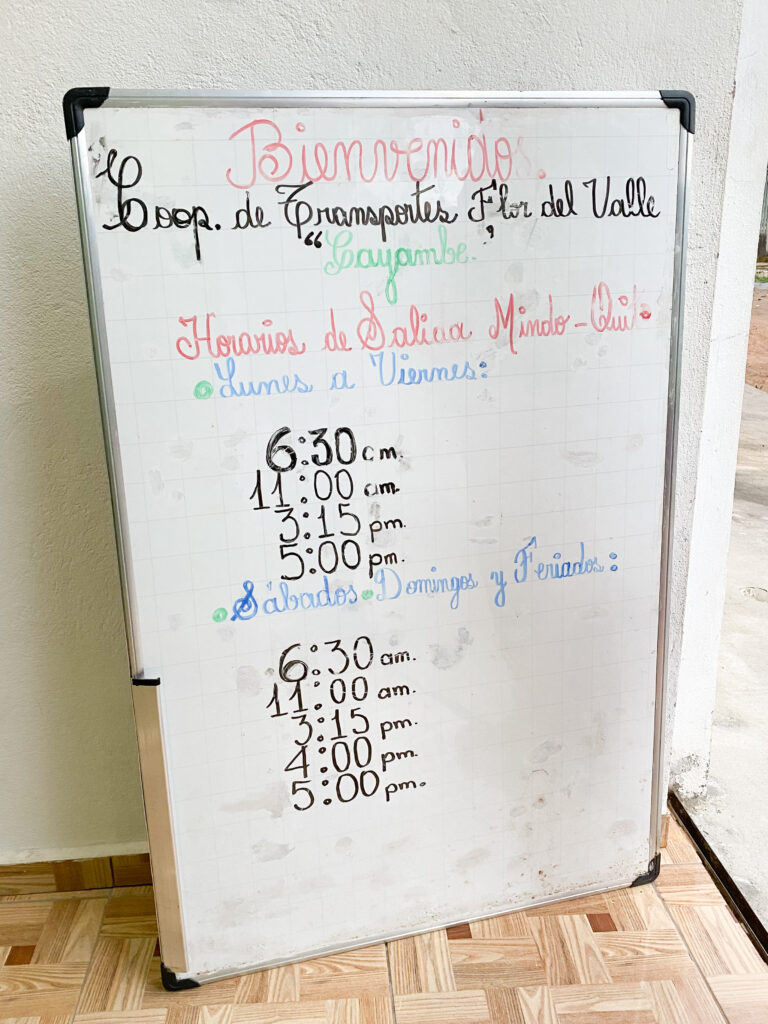
2. Taxi from La Ofelia to Carcelen station
We arrived to the La Ofelia bus station in Quito around 8:45am, and our next issue was to transfer to the correct station for the bus to Tulcan.
Buses from Quito to Tulcan leave from the northern bus terminal: Carcelen.
If you’re starting your journey from Quito then it makes sense to take an uber directly to the Carcelen station (yes, even though they’re technically illegal, I recommend taking ubers when possible in Quito because based on my experience they’re MUCH safer and reliable and you’re less likely to be scammed).
Side note: If you’re looking for accommodation in Quito, we really enjoyed Rebel Hostel . The staff here were particularly helpful with looking up border news (there were riots on the Colombian side a few weeks before our crossing which we had no clue about until they told us).
Since we were coming from La Ofelia station which is also in the north, Carcelen station was quite close. We took a taxi (from inside the station – not the street) for $3 USD, which took about 10 minutes.
Cost: $3 USD
Time: 15 minutes
3. Buy bus ticket to Tulcan, Ecuador
Once at Carcelen station, we had to buy our bus tickets to Tulcan. There are a LOT of daily departures from Quito to Tulcan, and a LOT of bus companies that operate this route, so don’t worry too much about exact times (just get there as early as you can).
Around the back of Carcelen station there is a row of like 6-8 bus companies all yelling “Tulcan!!!” at you. We just went to the least aggressive looking one (Vencedores). We paid $6 USD per person for tickets to Tulcan, but we also heard other vendors (like Expreso Tulcan) offering $7.50 USD. I’m pretty sure the prices just change depending on how soon they have a bus leaving and need to fill up seats.
When we bought our tickets, they gave us a couple water bottles (nice touch after all the screaming!), and a staff member even walked us from the ticket stand to the spot where the bus was leaving from. We waited around for a while and when our bus was loading up the staff member directed us toward it.
Cost: $6 USD per person
Time: 25 minutes
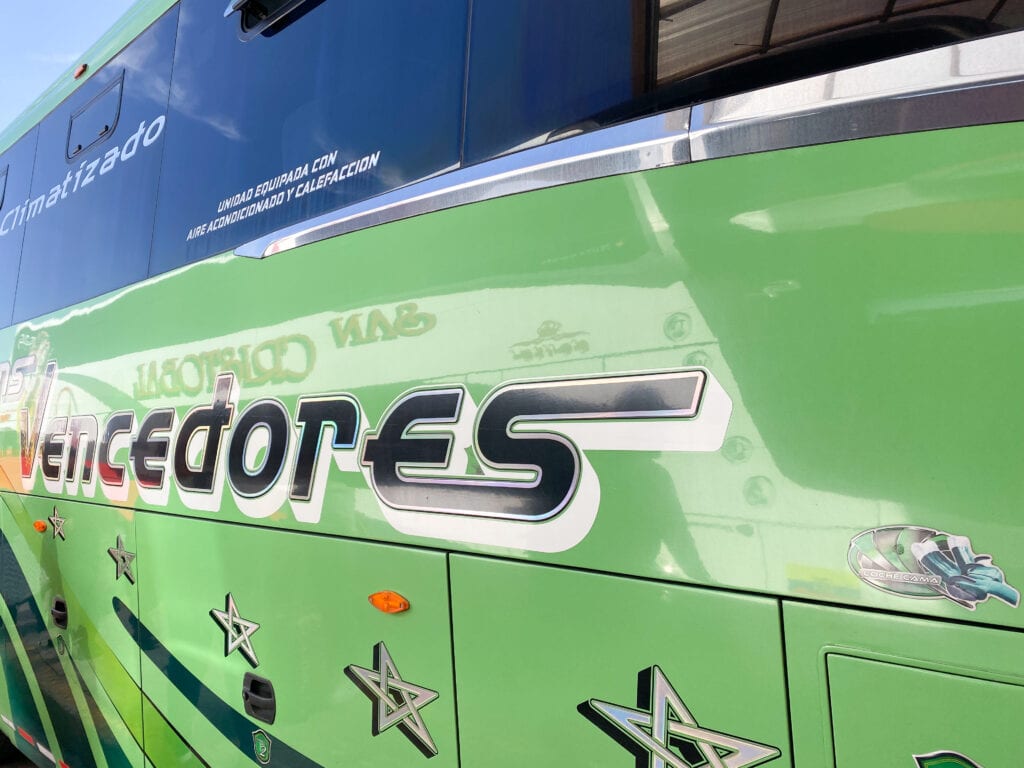
4. Bus from Quito to Tulcan, Ecuador
Our Vencedores bus (bright green) left at 9:25am. It seemed like there were buses leaving to Tulcan literally every 5 minutes though so don’t worry about getting that exact time. In fact, if you’re not coming from Mindo like us, then I recommend you get a much earlier bus to Tulcan (like, 6-7am).
Overall, the journey was relatively comfortable but long. We arrived at Tulcan in about the estimated five and a half hours at 2:55pm. Notably, we were the only gringos on the bus.
Cost: –
Time: 5 hours and 30 minutes
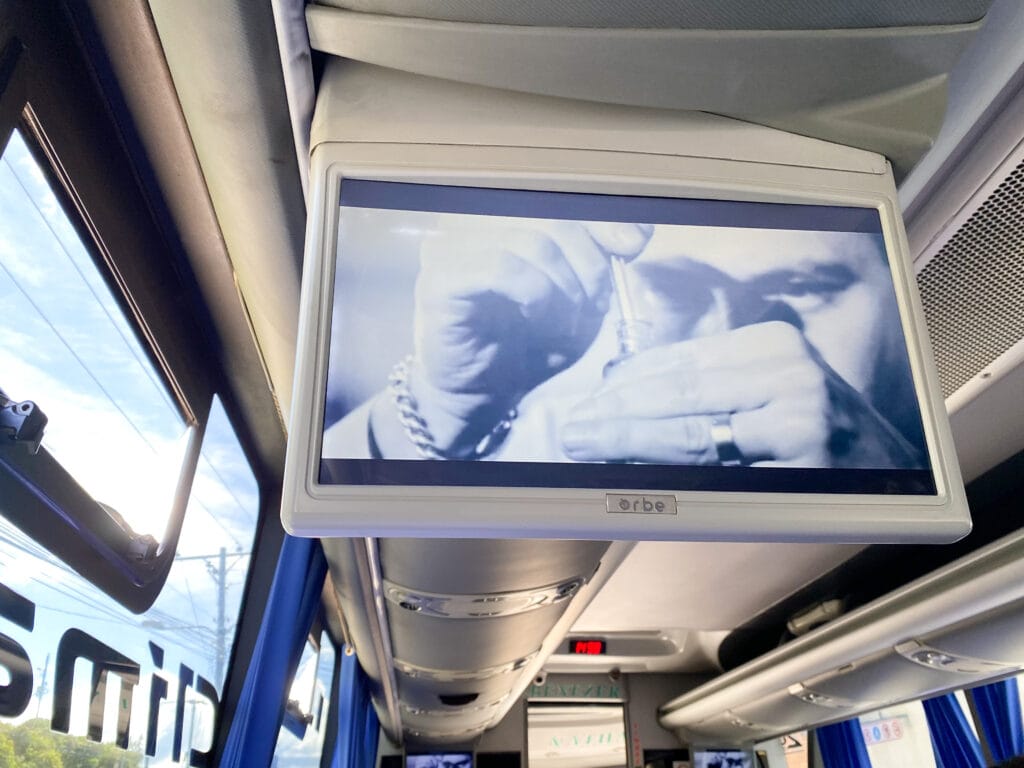
5. Taxi from Tulcan to the Ecuador Colombia border
The Tulcan bus station was a huge parking lot with some buildings surrounding it. We got off the bus and collected our bags. Dan bought some snacks here and used the bathroom (25 cents).
Our next step was to get from Tulcan to the Ecuador Colombia border. We saw three or four combis leaving for the border, but we didn’t want to wait for them to fill up.
Instead we took one of the many, many yellow metered taxis to the border (you will see tons of taxi drivers all shouting “frontera!” AKA “border!”). Our taxi cost $4USD and only took about 10 minutes.
Cost: $4 USD
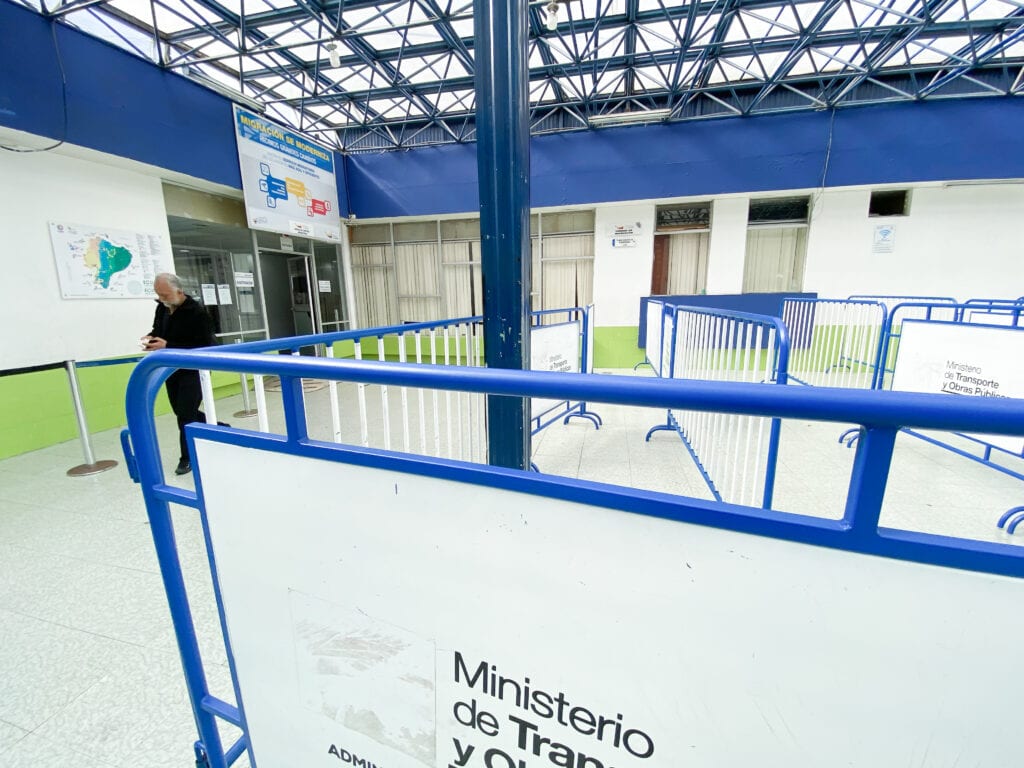
6. Exit Ecuador
It was about 3:10pm by the time we reached the Ecuador Colombia border. There is a big building here with a pretty obvious sign that says migraciones (immigration). This was our first stop.
There was no line when we arrived, so it only took about 10 minutes to talk to the Ecuadorian immigration officer and have our passports stamped. I checked my phone and it was only 3:20pm by the time we’d officially “exited” Ecuador.
Time: 10 minutes (could be a lot longer based on lines)
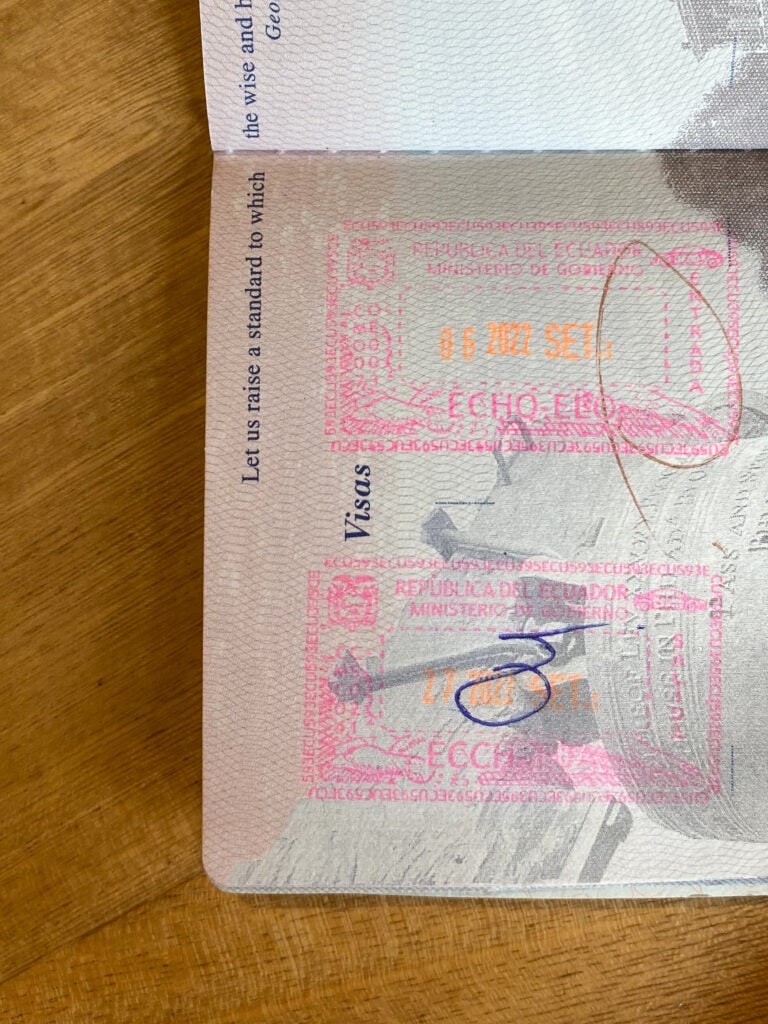
7. Complete MIG form (if not already done)
Update April 2023: A fellow traveler commented below that the check MIG is no longer required for land border crossings! However I couldn’t find any official websites that mentioned this change. Future travelers, please comment any updates below.
At this point, we became a little confused. The Rumichaca bridge which connects Ecuador and Colombia is pretty obvious, but we weren’t sure what to do next.
We still hadn’t completed our MIG form (required to enter Colombia), because we’d heard it was done for you at the border. So, we went to a small building by the bridge that had a sign that said “aqui su check-mig.” Weirdly, this was also like a combination snack bar.
It took ages and a surprise $6 USD each, but we got our MIG forms completed and printed. We had a small scare because my MIG form was approved in seconds whereas it took about 30 minutes for Dan’s to be approved. I’m a USA citizen and he’s a UK citizen, so we thought that could have something to do with it although we really aren’t sure.
Honestly, please save yourself the hassle and the $6, and just complete your MIG form the night before and save it to your phone. You can complete it online here .
Time: 40 minutes
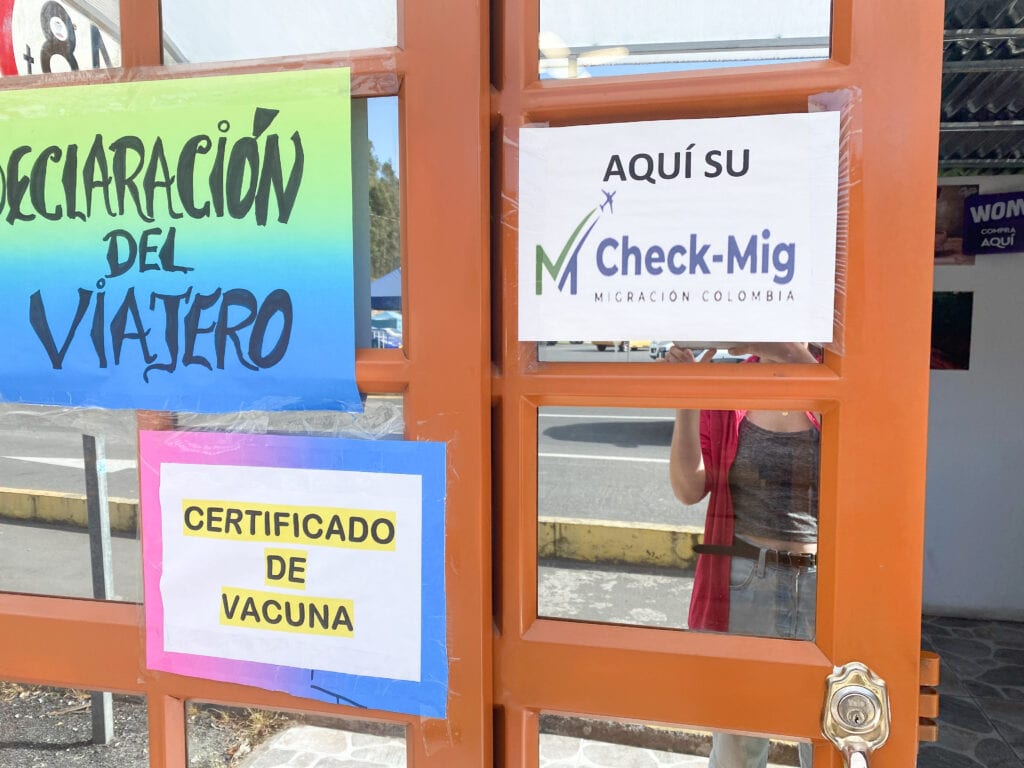
8. Walk across the Rumichaca bridge / no man’s land
Around 4pm, we were finally getting ready to cross the bridge to Colombia!
We had a delay here because on the Ecuador side of the bridge, there is a stand where someone checks your vaccination card, temperature, and health forms. An immigration officer told us that we needed to complete a health form before we could cross. We showed our just-completed MIG forms and they said no, that wasn’t the right form.
At this point, we were totally confused. We didn’t have any cell service and none of the public wifi worked so we couldn’t access this form that we’d never heard of. After another 45 minutes of struggle, and speaking to a couple helpful Ecuadorians along the way, we discovered that the health form was ONLY for people entering Ecuador, NOT for people entering Colombia. The immigration officer, I guess, had told us wrong.
So, we returned to the bridge once again, and walked quickly by the health stand and across the bridge. I kept thinking someone was going to come yelling after us and tell us to come back to Ecuador, but they didn’t!
Hopefully your no man’s land crossing experience is less confusing than ours. The short version is – don’t stop to ask anyone anything, just cross the damn bridge.
Time: 45 minutes (it really takes two minutes to cross the bridge, we were just confused)
9. Enter Colombia
Once you cross the bridge to Colombia, you still have to “enter” Colombia, AKA get your passport stamped. Weirdly, you have to walk through a bunch of taxi drivers and money exchange guys first in order to reach the immigration office.
I see how it could be easy to accidentally just hop in a taxi and yeet out of here at this point, but DON’T! You’ll end up in major immigration trouble later if you forget to get your passport stamped.
The Colombian immigration building has a big sign that says “salida Colombia” and “ingreso Colombia.” Go to the “ingreso” (enter) side. Again, we had no line here so it only took 10 minutes total to answer a few questions, show our MIG forms and vaccination cards, and get our passports stamped.
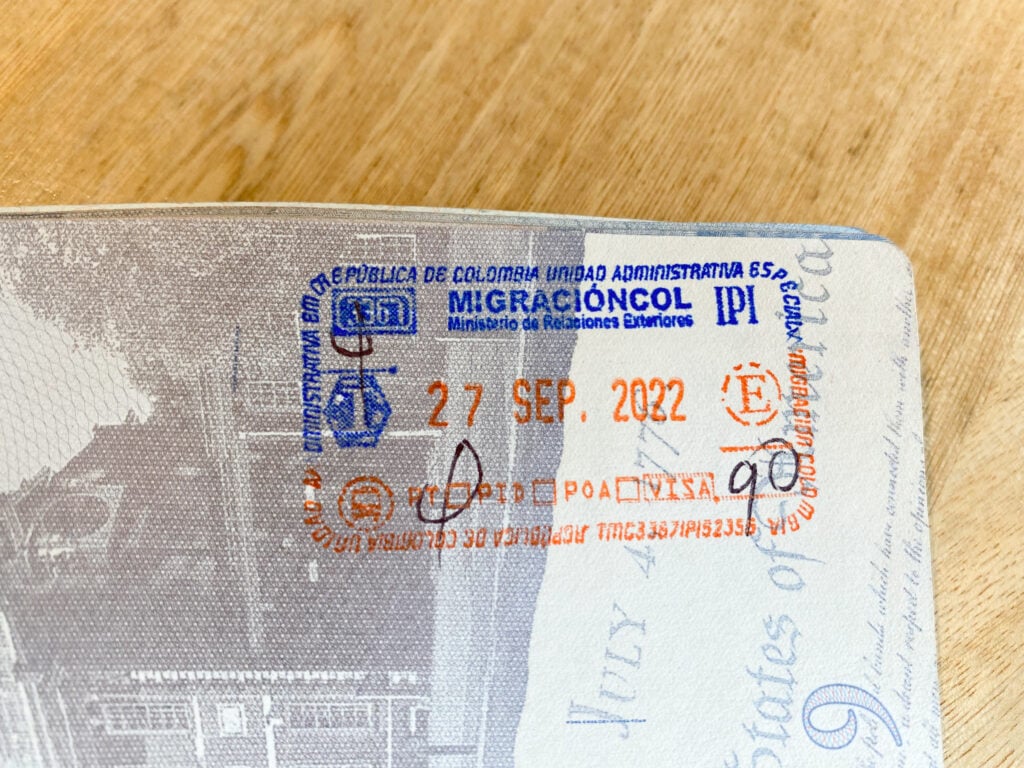
10. Exchange USD to COP (optional)
At last! At 5pm, we were officially in Colombia!
We decided to exchange some USD to Colombian pesos at the border, solely because entering a country with zero of its currency is not very smart.
However, the exchange rates from the men walking around the border are obviously really bad. We only exchanged $20 USD and got 84,000 COP back (exchange rate 4,200 COP to 1 USD). For reference, the actual exchange rate at the time was 4,550 COP to 1 USD, so we essentially lost 7,000 COP (around $1.58 USD).
For us, that was completely worth it for the safety of having a few Colombian pesos in our pockets, and I’d recommend you do the same.
However, it’s smart to be prepared and know the exact exchange rate of the day ( check here ). Also, count through all your COP before you hand over your USD. Unfortunately, some people may try to take advantage and swindle you by giving you smaller denomination currency.
Cost: $1.58 USD (currency loss)
Time: 10 minutes
11. Taxi to Ipiales, Colombia
Finally, we were ready for the last step of our Ecuador to Colombia border crossing journey. From the border, your next step is to take a taxi to Ipiales.
Ipiales is the closest Colombian town to the border. Whether you decide to stay the night in Ipiales (like we did – I recommend it), or if you’re traveling onward to another destination in Colombia, you need to get to Ipiales first.
It was easy to get a taxi from in front of the Colombian immigration office. We paid $4 USD to get to Ipiales (you can pay in either USD or COP here), and it took 10 minutes.
In Ipiales, we stayed at Hotel Royal Class , and I highly recommend it. First of all, it’s incredibly cheap at just $12/night for a private room with private bathroom. It’s clean, our room was really spacious, and there was a hot shower. There was also 24/7 security and cameras, and just a one minute walk to a grocery store and some restaurants for a quick and safe dinner. Check rates and book here .
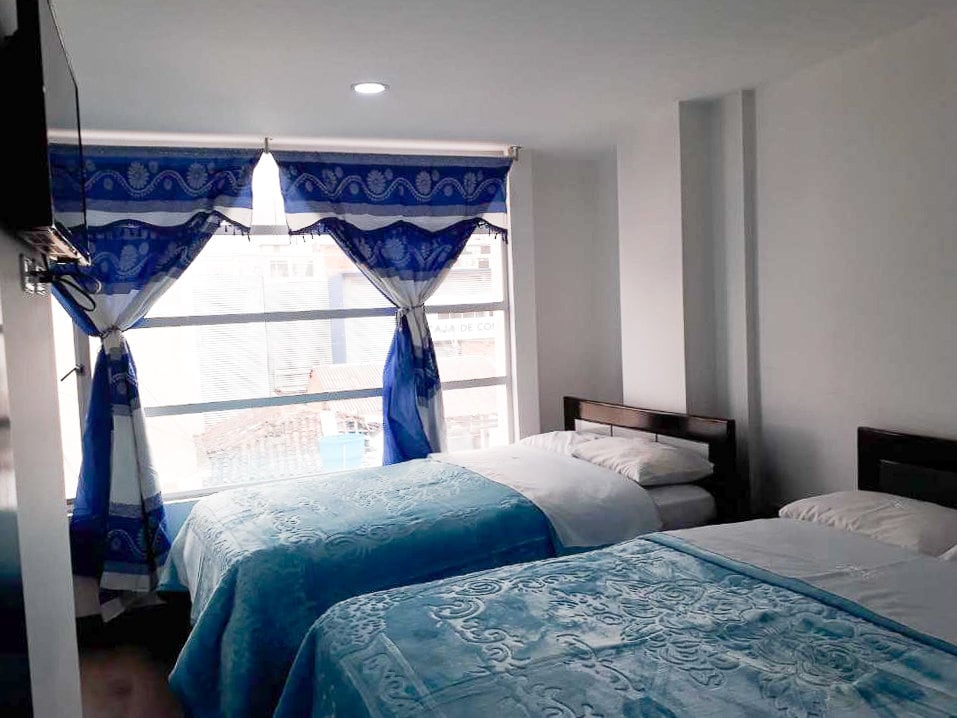
Onward Travel From Ipiales Colombia
From Ipiales, there are a couple options. Some travelers stay the night in Ipiales, and others head straight to the Ipiales bus station and travel onward to Pasto (a Colombian town with a bigger bus stations with more connections).
Personally, I highly recommend staying the night in Ipiales. Hotel Royal Class is my recommended accommodation. Honestly, it’s not worth the risk of traveling in this region at night. Our border crossing went about as fast as you could hope for, and it was still dusk by the time we arrived in Ipiales.
Another reason to stay in Ipiales is that you can visit the incredible Las Lajas Sanctuary the next morning, before traveling on to your next destination in Colombia. Seeing this gothic church that straddles a river, surrounded by waterfalls and Colombian countryside, is a sight so remote and unusual that you will likely never see anything like it again. Why waste the opportunity?
Other options for onward travel from Ipiales include:
- Pasto: There’s no touristy reason to visit here; it just offers better transport connections. Take a minivan from Ipiales terminal, which leaves every half hour and takes about 1.5 hours.
- Popayan: A beautiful white colonial city. The day after our border crossing, Dan and I visited Las Lajas Sanctuary and then took a bus to Popayan where we stayed for the night. A lot of people love Popayan but we had a really bad experience here – which I’ll save for another blog post. Nevertheless, it still makes a lot of sense to spend a night here on your way to the coffee region. From the Ipiales bus terminal take a Transipiales bus (green), which costs 50,000 COP / $10.75 USD per person, and leaves hourly. You’ll be told it takes 7 hours but our journey was nearly 10 hours.
- Cali: A big, somewhat seedy city known for its salsa culture. We passed by Cali but it’s worth a stop if you want to learn salsa. From Ipiales terminal, Cootranar buses leave hourly. The journey is 10 hours and costs approximately 83,000 COP / $18 USD.
- Salento: A gem of Colombia’s coffee region. We spent five days here! It’s too far to reach in one day from Ipiales. We took the bus to Popayan, stayed the night in Popayan, and then took the Tax Belalcazar bus the following day to Armenia (6 hours) and then the minibus to Salento (1 hour).
- Medellin: Again, too far to reach in one day from Ipiales. From Popayan, you can take a direct Flota Magdalena bus to Medellin (10 hours). However, I don’t recommend that. You should definitely stop in Salento and Jardin on your way to Medellin.
- Bogota: Likewise, too far to reach in one day from Ipiales. You could travel here via Popayan, Cali, or Salento.
For more onward travel plans, Rome2Rio is my go-to free tool to figure out travel routes.
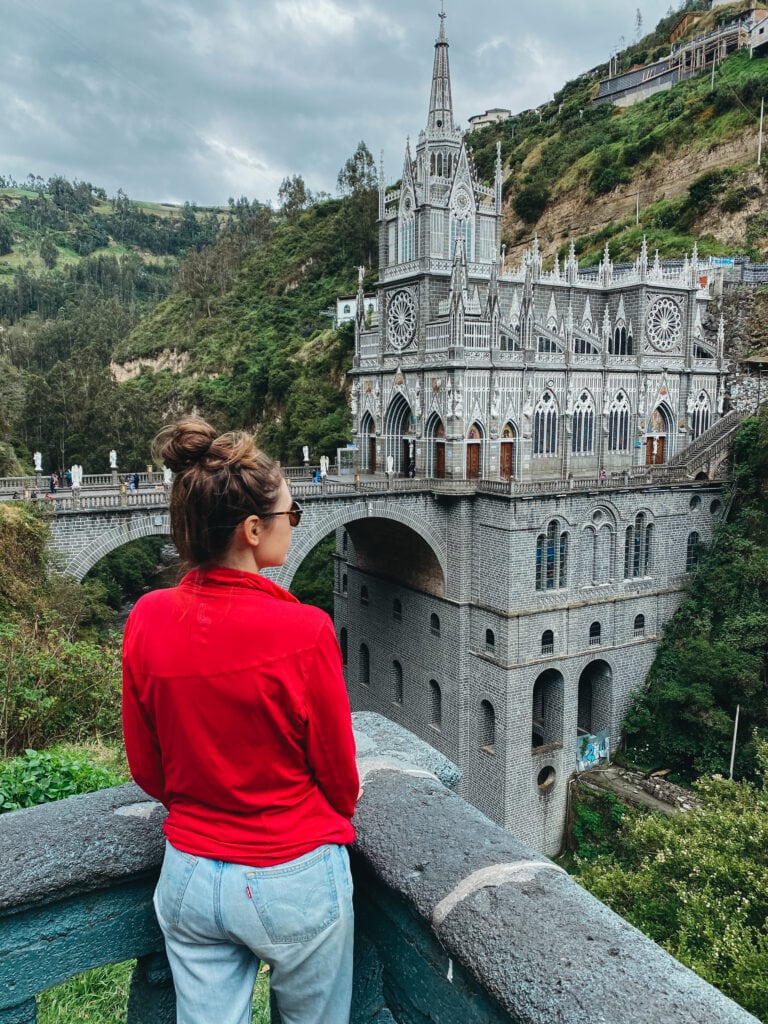
Ecuador Colombia Border Crossing Overview
Everyone’s border crossing experience is going to be different. Ours is based on traveling from Mindo, and also traveling in a couple (so we split taxi costs). We also had basically no lines at the border, and our only delays were due to confusion on our part and the immigration officers’ parts.
Total time: 12 hours
Total cost: $43.78 USD total or $21.89 USD per person
Why Not Fly Between Ecuador and Colombia?
WOW, that was a long post. As you can see, it’s rather complicated to travel by land between Ecuador and Colombia! At this point, you might be wondering, why not just fly from Ecuador to Colombia?
Honestly, this is something we thought a lot about in the weeks leading up to our Ecuador Colombia border crossing. We’d even heard about some recent riots in Ipiales in the weeks before we crossed, which made us seriously look at flight prices.
The thing is, flights between Quito and Bogota are super expensive. When we checked, they were over $300 USD one way, before adding luggage. Considering our total cost for traveling by land came to $21.89 USD per person, that’s a lot of money.
Also, by flying you will miss out on the Las Lajas Sanctuary. It’s a loooong journey to visit this church if you’re not planning to cross the border to Ecuador or vice versa, so chances are you’ll probably never see it.
Safety Tips for the Ecuador Colombia Border
I didn’t feel imminently unsafe at the Ecuador Colombia border (like I have in other places like Popayan), but I also did feel on edge the whole time. This border crossing isn’t known for being super dangerous, but it’s also not known for being super safe either. Take from that what you will.
In order to remain safe at the Ecuador-Colombia border, here are a few tips:
- Leave Quito as early as possible, to give yourself plenty of daylight to complete the border crossing.
- Don’t cross the border at night.
- Don’t travel onward from Ipiales after dark as it’s unsafe, particularly the Cauca departmento (which has a level 4 travel warning from the US – except for the city of Popayan).
- Stay up to date with border news on Ecuadorian and Colombian news websites. Riots happen here but typically aren’t reported in USA, UK, and other english language news. I highly recommend asking your hostel or hotel staff in Ecuador to check the news for you. We found that the staff at Rebel Hostel in Quito was particularly helpful with this.
- If you are a solo female traveler, consider joining up with other travelers for this border crossing, or alternatively just flying from Quito to Bogota. I had Dan to cross this border with, but I would’ve been very uncomfortable to cross here by myself. Even in five minute stints without Dan by my side, I had men hassling me.
- Complete your MIG form ahead of time so you can reduce your time spent at the border itself.
- Have some USD cash on hand to exchange into COP.
- Keep your valuables (camera, phone, jewelry, wallet) either zipped away in your backpack or only use discreetly. Try not to draw attention to yourself.
Final Thoughts on the Ecuador to Colombia Border Crossing
I really hope this guide was helpful to any fellow travelers attempting the Ecuador to Colombia border crossing! It’s definitely one to be prepared for as it’s more complicated than other border crossings.
If you find this guide helpful for your own border crossing journey, I’d really appreciate it if you leave a comment below. Let me know how your trip went, and any updates or changes from what I’ve written here. I will keep this blog post updated so it remains useful for all of us!

Pin it for later…
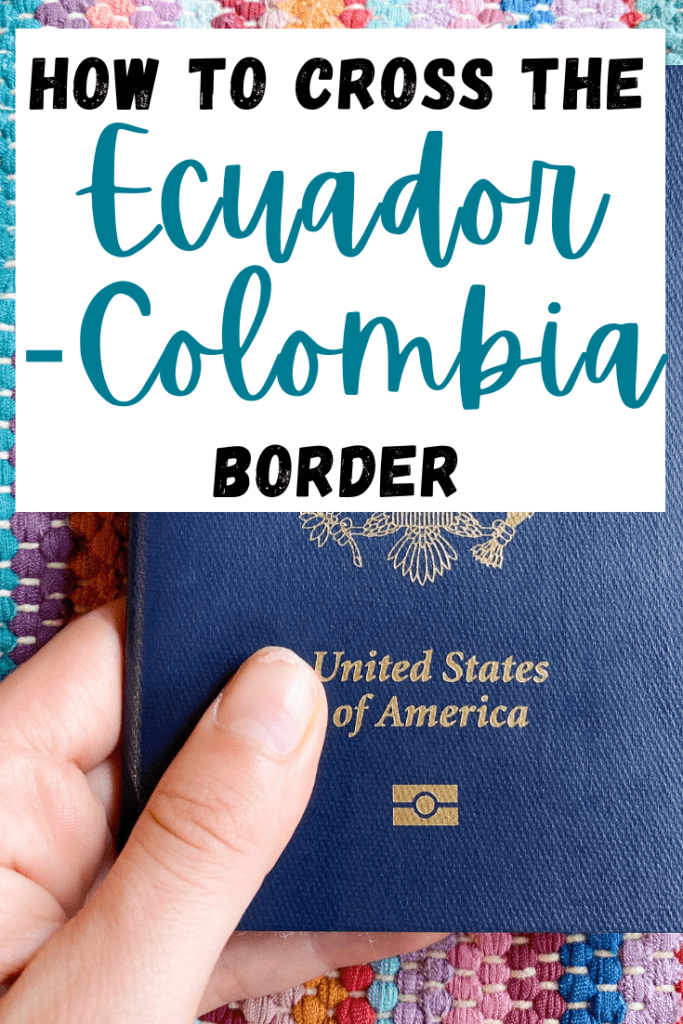
Looking for more?
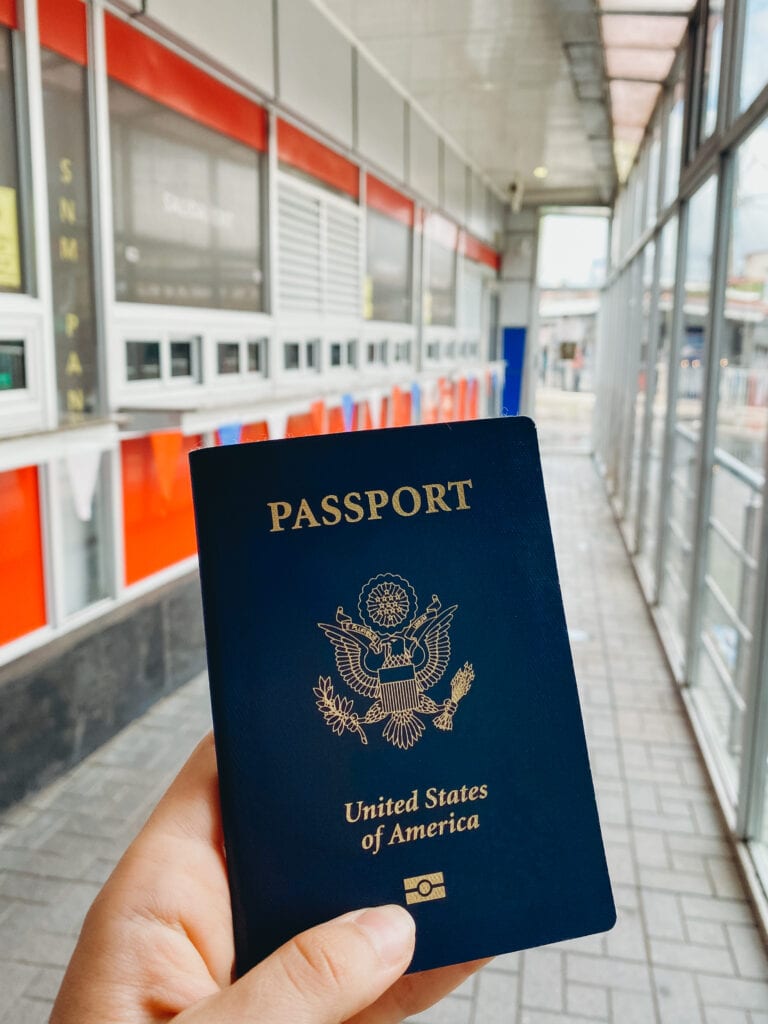
Panama to Costa Rica Border Crossing: The Complete Guide (2024)
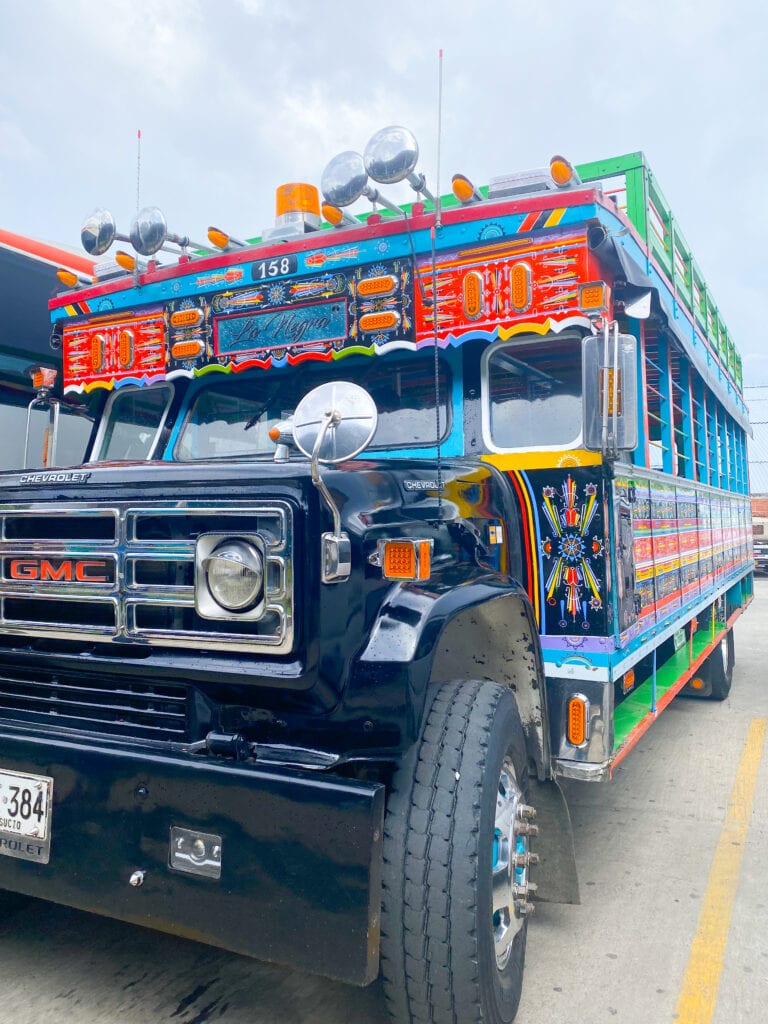
Salento to Jardin: Exactly How to Get From Salento to Jardin by Bus (2024)
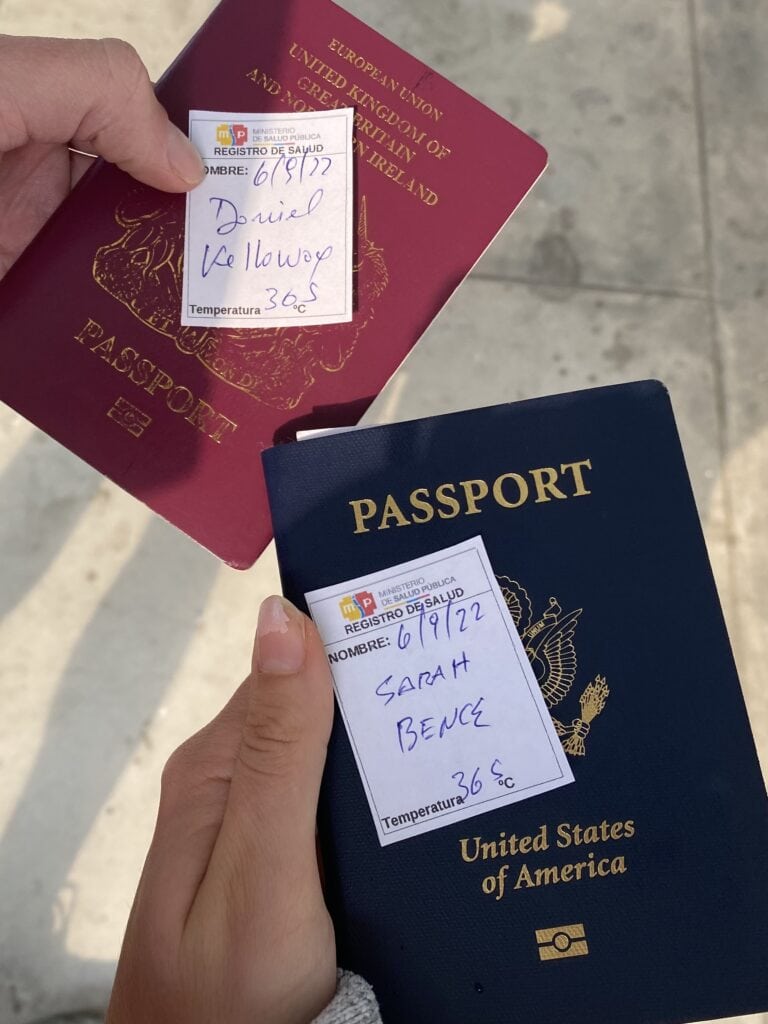
Peru to Ecuador Border Crossing: The Complete Guide (2023)
17 comments.
Thank you for the guide – helped us a lot. However, we wasted two hours trying to fill out the MIG, before we found out, that this is NO longer needed in April 2023, when it comes to land crossing. Thanks
So glad it was helpful! I have tons of other Latin America border crossing guides if you’re backpacking long term 🙂 Thanks for the update about check MIG. I updated the post in a couple places to mention your experience. Did you find that info on any official websites? I couldn’t find it anywhere.
This information was amazing. Thank you. I just did this crossing and arrived in my hostel in Ipiales now, 19th June 2023. I didn’t need the MIG form. I asked the guy ushering people in and he said it’s not necessary. I also wasn’t asked for any information except the hostel I was staying in Ipiales. I’m a UK citizen for your information. The crossing was really much easier than I expected. And it took me at most 15 minutes from stamping out in Ecuador to stamping into Colombia. However I later found out it’s a national holiday today in Colombia. So that’s why it was so quiet on the border.
I’m so glad the border crossing went smoothly for you. Now, enjoy Colombia!! One of the best places ever!
I have lived in Ecuador twelve years and have ever been stopped at the Rumichaca border crossing. I am a U.S. transplant. You might want to try Mondays. And depends a lot on your mod of transportation. Taxi driver and one person is the best bet. Monday is a slow day and usually no one in line.
Thank you so much for such a nice detailed description of this border crossing. You mentioned an unpleasant situation in Popayan, I haven’t found anywhere else on your website info about that, first, I’m sorry to hear you had such a case, could you tell us what is was specifically? I’m planning to go there and wanted to have every possible detail too. Thanks!
Hi Daniel! I’ve sent you an email to the address that you listed when you left the comment. I haven’t decided how/if I’m going to share our Popayan story publicly on the blog yet but I did send you all the details. Hope it helps you make your decision.
Hi, Thanks for the really helpful blog post, we are heading to Colombia in the next few days. But I’d also like to hear of your not so good experience if possible. Thanks in advance 🥰
Hi Hollie, we got stuck on a road during a gun fight in Popayan. Most terrifying experience of my life. I’d recommend not to go out after dark there and try to get a bus that arrives during daylight hours (and expect it to be delayed a few hours) – if you haven’t already passed through the area that is!
Hey. Thank you so much for your guide! As a solo female traveller it helped a lot and made me prepared for the crossing. I just crossed the border today and can confirm that the MIG is no longer needed. I tried to do it online, but that’s not even possible (you can’t select to cross by land – only by air) In fact, I only had to show my passport at the border, so everything went nice and smoothly!
Thanks for the extensive guide, it helped us much preparing for our crossing earlier today. Two notes that might be helpful 1: We took the bus from the Quitumbe bus terminal in Quito (South), although you do stop in the Northern station as well, you can get a bus from the Southern station. 2: Upon wanting to filling out the MIG form beforehand we found the website to not be properly working (and so did not manage to fill out the form). When arriving at the migration office at the Colombian side today they did not ask for it at all and we just passed without it. Cheers!
Hi Sarah I am currently in Ecuador and will be heading back to Colombia soon. I was told I would not need a PCR test for land border crossing…is this true?
Hello, This is super helpful, we are going from Colombia to Ecuador in a few days. I wonder if there is any comments you have about crossing the border on a weekend vs a weekday? Either option better? Thanks! Hannah
Hi Hannah, we crossed the border last week using your detailed guide and it was so helpful – thank you! It seems the MIG form is definitely not needed for land border crossing at present and if you try to complete the form online it’s physically impossible to tick the land entry box on the online form. Thanks again for writing this – it was so helpful.
“The Check-Mig is mandatory for all passengers entering Colombia by air, while the requirements for a Colombian visa depend on the nationality of the traveler.’ This was found on this website – https://www.colombia-checkmig.com/
Thank you a lot for this guide! It was really helpful for crossing the border. I crossed it two days ago (17-11-2023) and all was fine. Note: I didn’t need a MIG form! We crossed it actually in the the evening in the dark, but still al was fine! Greets from a Dutchie:)
Hello, Thank you for such a detailed post. We are leaving in 2 weeks and plan to use this crossing. I will update you after our trip. However, I was looking for the info – can I cross this border with rental car from Ecuador (this brings me to your site). Would you know anything about it? Thank you, Tatjana
Leave a Reply Cancel reply
Your email address will not be published. Required fields are marked *

Everything You Need to Know About Crossing the Colombia-Ecuador Border
January 27, 2023 mark.
Greetings from Quito, Ecuador ! We are so happy to be resuming our year-1 travel plan since the protests in Peru threw a monkey wrench into our itinerary. Needless to say, crossing the Colombia-Ecuador border on foot to get to Quito was not part of the plan!
We were supposed to arrive in Quito, Ecuador like most travelers do – by plane . But we were forced to leave Peru 1 month earlier than planned. Thankfully we were able to adjust our travels on the fly and spend that time in Colombia without busting our budget.
But this presented a new problem.
Flights from Santa Marta, Colombia to Quito, Ecuador were not cheap, costing hundreds of dollars for each ticket! And since we already had our Ecuador Airbnbs and exit flights locked in, we needed to find a budget-friendly way to get to Ecuador from Colombia so we could resume our year 1 travel plan .
Thankfully, crossing the Colombia-Ecuador border by foot ended up being the perfect solution. It was safe, cheap, and surprisingly drama-free. It does take more planning and requires a bit more schedule flexibility to pull off. But these are no big deal to Two Travel Turtles , especially if it saves us money!
So let us show you how we made our run for the Colombia-Ecuador border and arrived in one piece in Quito, Ecuador . That way, you can too!
A TTT Guide to Crossing the Colombia-Ecuador Border
Day 1 – get to ipiales, colombia, day 2 – cross the colombia-ecuador border and get to quito, ecuador.
- Closing Thoughts
Our journey to Quito, Ecuador was completed over 2 days, with different goals each day:
The Colombia-Ecuador border crossing is very close to Ipiales, Colombia ( Google Maps ), so most travelers going to Ecuador this way use Ipiales as a staging area. This is what we did, and is what we recommend to other like-minded travelers. Keep in mind that there are several ways to get to Ipiales , but because of its distance from Taganga , Colombia , air travel was the best method for us.
And once we crossed the border, we would have to find bus travel that would take us to Quito, Ecuador .
So here is our blow-by-blow account of what happened during our two-day journey.

Day 1A – Fly to Pasto, Colombia
The closest airport to Ipiales is Aeropuerto Antonio Narino ( Google Maps ) in Pasto, Colombia .
So on January 25, we left our Airbnb in Taganga, Colombia , and flew to Pasto, which required a 5-hour layover in Medellin . We flew on Viva Airlines and our mid-grade tickets would have cost us $57.82 USD each . But we used points from our Capital One Venture Rewards credit card (affiliate link) to pay for them, so they were effectively free.
We left for the airport at 6 am and took a taxi directly to the Simón Bolívar International Airport outside Santa Marta . Normally this taxi would have cost us $50,000 COP ($11.05 USD) , but by coincidence, our Airbnb host needed to go to the airport at exactly the same time. So we were able to share the cab!
And our host surprised us by paying the entire fare to make up for the intermittent electricity and internet disruptions we experienced during our Airbnb stay. This was completely unnecessary considering this is a semi-regular occurrence in our remote area of Colombia .
But he insisted so we accepted!
Our flight was supposed to leave Santa Marta for Medellin at 9:15 am. And when we landed in Medellin the plan was to use free airport lounge passes to spend the time productively writing and studying.
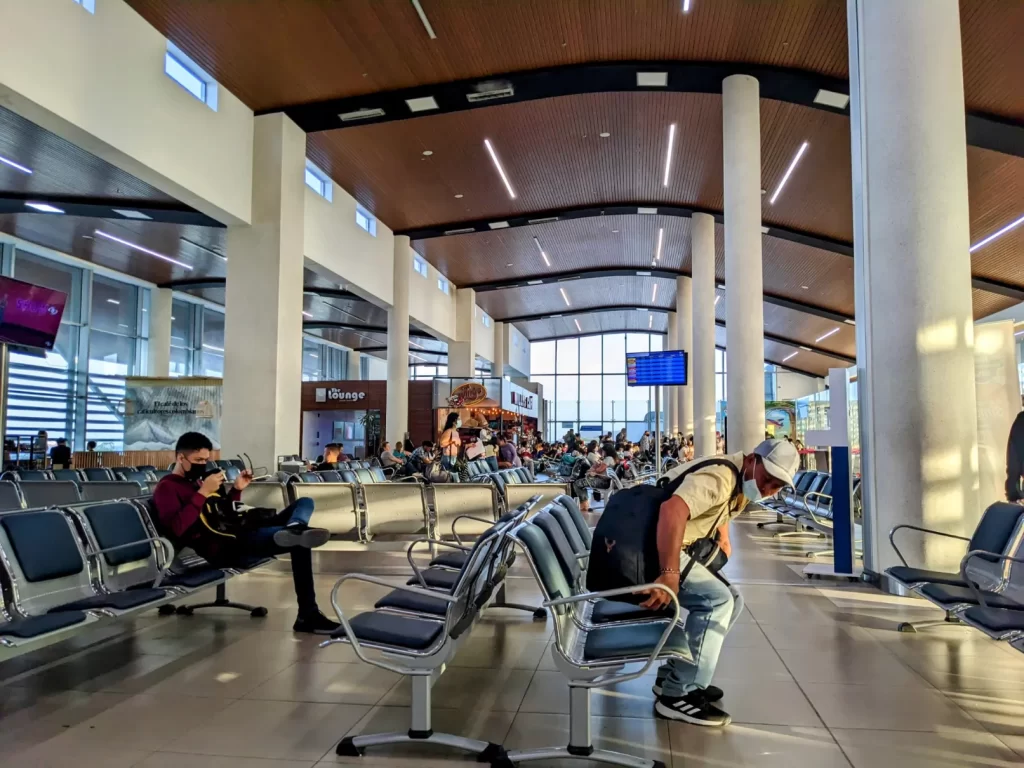
Unfortunately, our flight to Medellin was delayed by two hours and we ended up landing at around 1 pm.
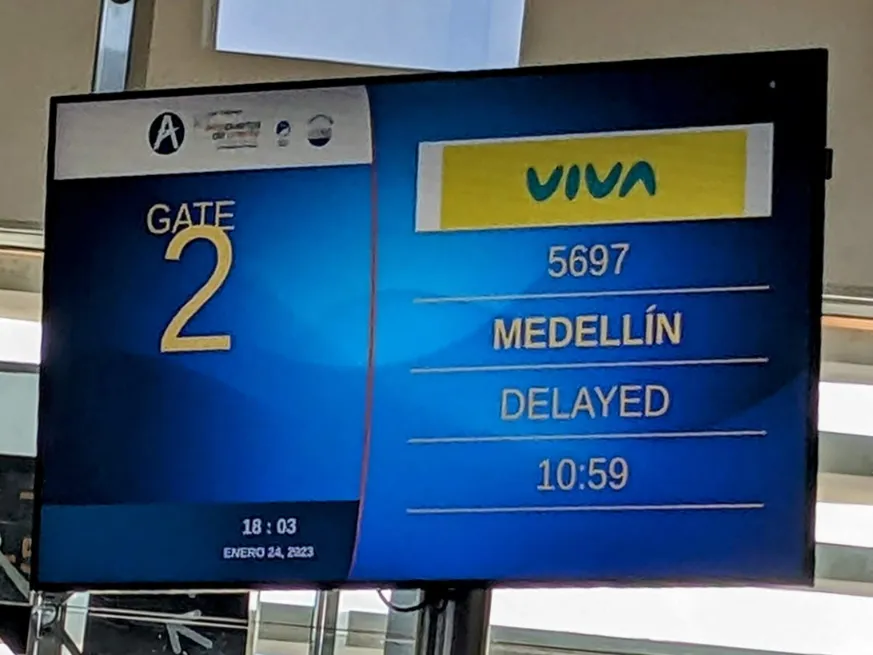
So instead of wasting our passes on a short lounge stay with mediocre amenities, we just grabbed a couple of burgers in the main concession area and waited things out.
Thankfully, our flight from Medellin to Pasto, Colombia was on time, and we landed without incident at 4:50 pm. And once we got situated, we left the Pasto airport entrance at 5:15 pm.
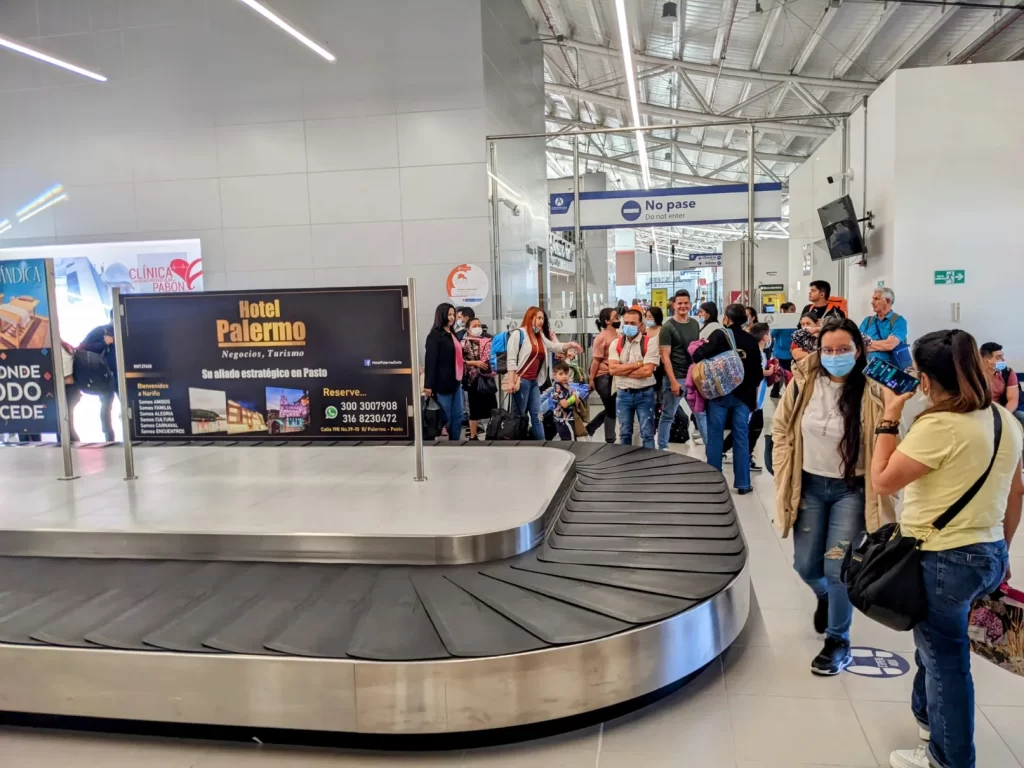
Day 1B – Get to Ipiales, Colombia
Now that we were in Pasto , we normally would have explored public transportation options to get us from the airport to Ipiales . But they involved multiple steps, more time, and a not-small amount of uncertainty as to whether the bus station in Pasto would be open when we arrived.
Night was falling and we didn’t want to get stuck in Pasto , so we took a shared taxi directly to Ipiales . It wasn’t cheap at $150,000 COP ($33.20 USD) , negotiated down from $200,000 COP . But it was a 2-hour ride, so perhaps it wasn’t so unreasonable for a taxi. And it likely saved us an hour of extra travel time.
Here is the taxi route we took:
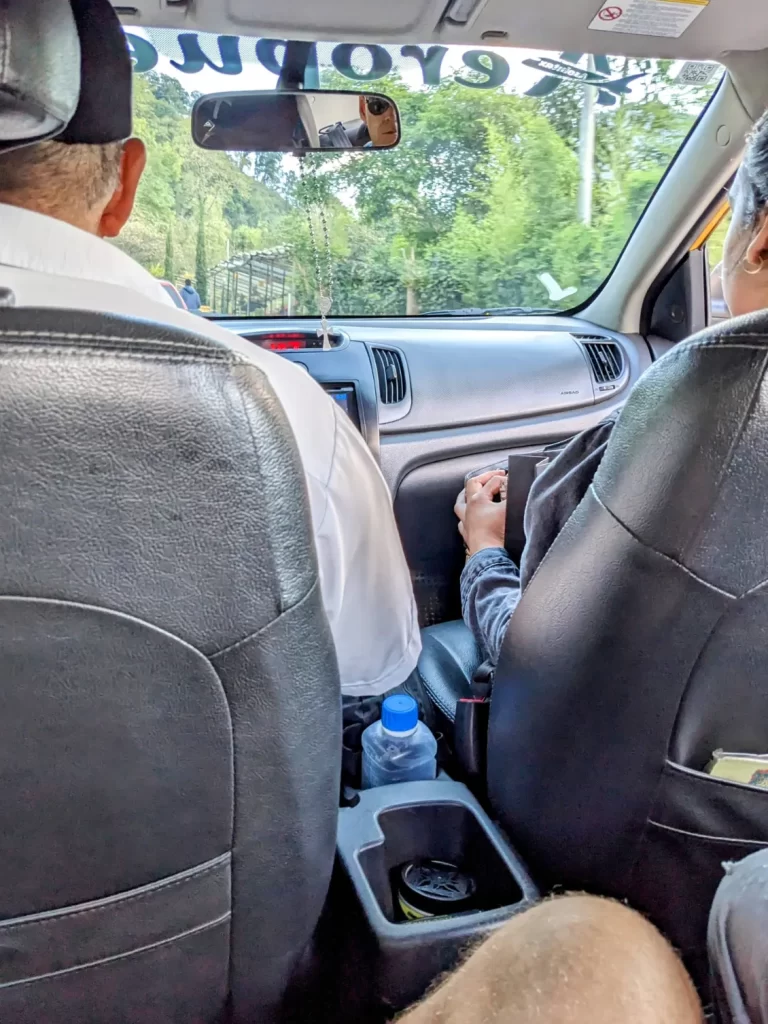
If we arrived at Pasto earlier in the day, we would have done things a little differently.
We would have taken a taxi from the airport to Pasto Bus Terminal , and then from there a cheap bus to Ipiales . Getting to Ipiales this way would have saved us at least $20 USD, but sometimes you need to spend a little more to avoid putting yourself in an uncertain situation without a plan B.
The taxi ride to Ipiales was gorgeous! Tons of majestic mountain views on surprisingly well-kept roads. Thankfully there was still enough sun to appreciate the views for most of the trip.
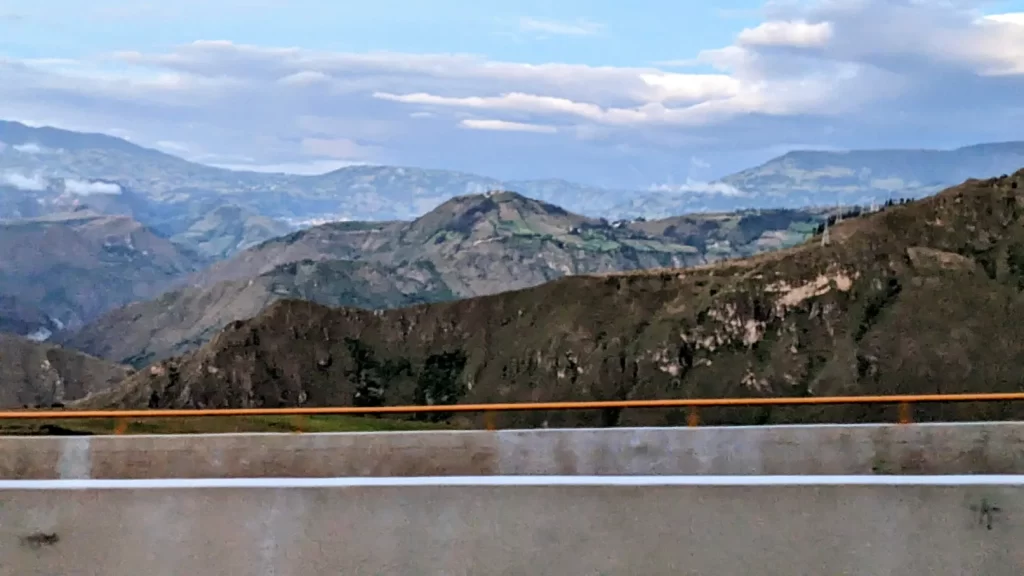
We arrived at the Ipiales Bus Terminal at around 7:15 pm. Many taxis were waiting for passengers here, and there were several hotel options right next to the bus terminal where reservations in advance are not needed.
We decided to stay at Hotel Mowa ( Facebook ; Google Maps ) because it was 50 meters from the bus terminal, had solid reviews, and had a good, cheap local restaurant built into it. And its proximity to the transfer station was truly a blessing because getting a taxi the next morning to the border crossing would be super easy. If Hotel Mowa were not available for some reason, Hotel San Jose would have been our next choice.
A room for two, with a hot shower, internet, and TV was only $60,000 COP ($12.84 USD) . The room was small, the bathroom comparatively large, and it was quite comfortable for a night’s rest. And we were shocked at the overall cleanliness of the hotel. It was absolutely spotless!
After we checked in, we first dropped off our luggage in our room. We then ate at the hotel restaurant, which was really good and cheap! But we didn’t explore Ipiales since it was so late and we were so tired. Over dinner, we watched some of the Brazil vs. Colombia football match on the TV with the locals, then crashed in our room when we were done.
For a one-night stay for use as a staging ground for crossing the Colombia-Ecuador border , Hotel Mowa was a great choice.
Day 2A – Crossing the Colombia-Ecuador Border
The next day (Thursday, January 26) we left the hotel at 6 am to get to the Colombia-Ecuador border . We hired a taxi to take us on the 15-minute trip to the Rumichaca Migration Office ( Google Maps ) on the Colombia side of the border.
Our taxi fare was $15,000 COP ($3.76 USD) , which we haggled down from $20,000 COP. The price was still a little steep based on what we were expecting, but we wanted to get on with our day.
6 am may seem excessively early to make the Colombia-Ecuador border crossing . But there are stories where people had to wait in line for 5 to 10 HOURS to make it through the process.
So we went as early as possible to try to avoid this problem.
When we arrived at the Rumichaca Migration Office at 6:15 am, workers proactively directed us in the correct direction to get our passports stamped by the Colombia Immigration Office .
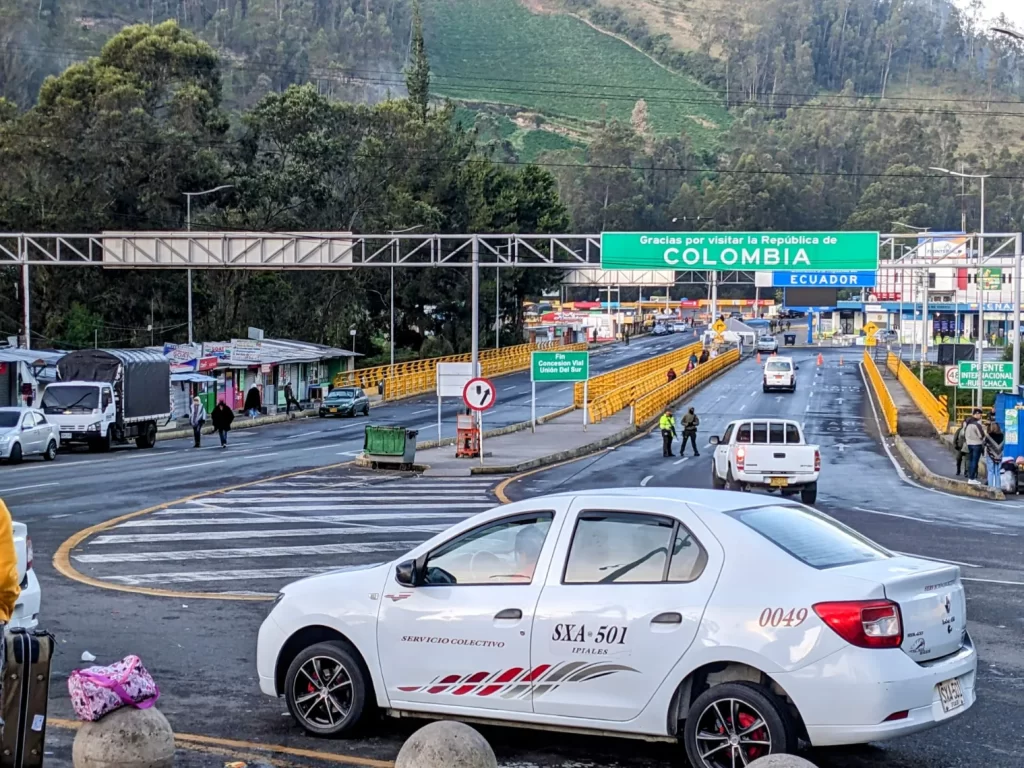
There was no line, and the process only took 5 minutes.
Having gotten our Colombia exit visa stamps in our passports, we were directed to walk across the bridge spanning Rio Chiquito , which took us into Ecuador . We were the only people making the walk into Ecuador !
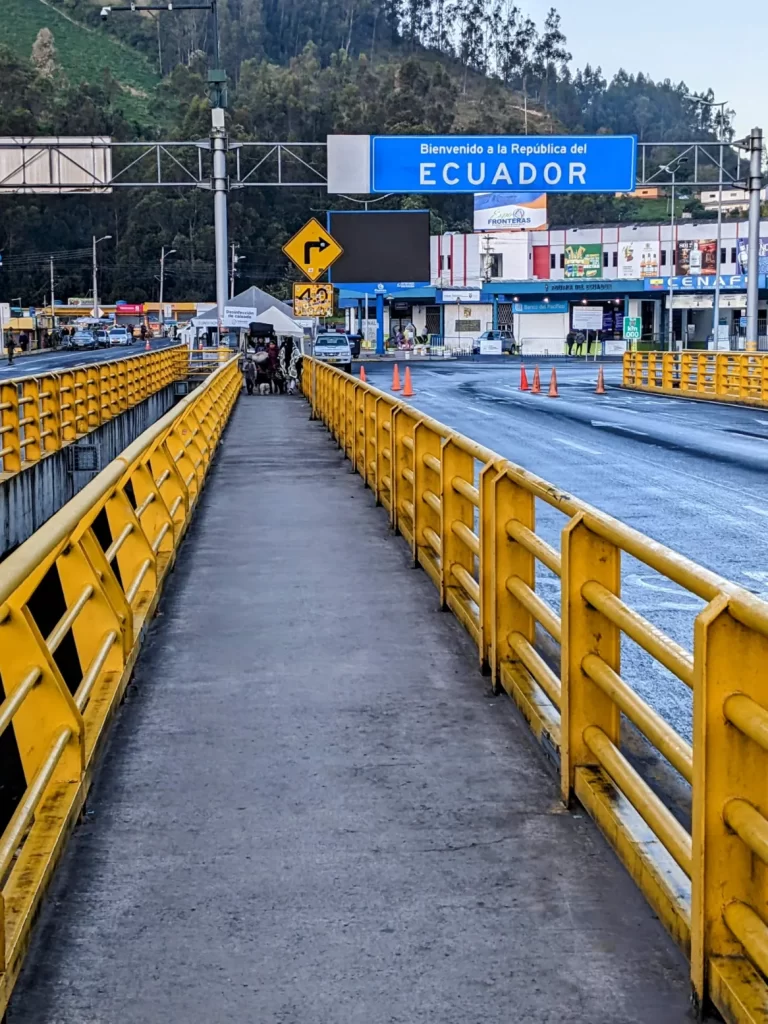
When we reached the other side, we immediately entered the Ecuador Immigration Office building. You could definitely tell from the barrier setup that long lines are a regular occurrence here.
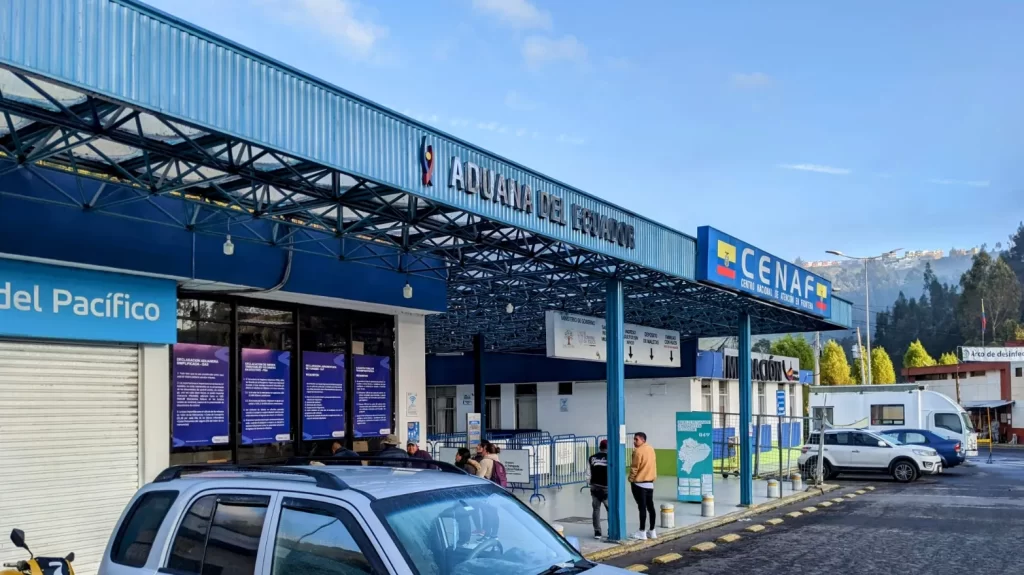
We entered the building and saw that there were only 6 people ahead of us waiting to see one of the 3 available immigration control officers. Signs outside the office instructed people to leave their luggage outside, but no one ahead of us did. So neither did we!
No point in risking theft if you don’t need to.
We waited no more than 5 minutes in line. And when we met our immigration control officer, there was little discussion. Once I told the officer that we were going to Quito , he inspected our passports in silence, stamped them, then sent us on our way.
NOTE: If you are not from the United States, you may need to apply for a separate visa in advance to cross the Colombia-Ecuador border. So do your due diligence and check before you try to cross!
All in all, this was a seamless border-crossing experience. When I checked the time after our passports were stamped in Ecuador , it was 6:38 am.
The entire Colombia-Ecuador border crossing process only took 23 minutes!
Based on our experience we strongly recommend anyone attempting this crossing leave Ipiales for the Colombia-Ecuador border at 6 am on a weekday. If you do, we think you’ll have the same positive outcome.
Day 2B – Getting to Quito, Ecuador
But we weren’t done yet!
Now we had to actually get to Quito , Ecuador since we successfully made it across the border. Thankfully this process was just as smooth as the border crossing!
Our first task was to get to the Bus Terminal in Tulcan, Ecuador ( Google Maps ). We needed to get to Tulcan because that is where you can charter a bus to Quito !
So once we were done at Ecuador Immigration, we exited the building and saw a parking area with lots of white collectivo minivans and taxis, all of which were vying for our business.
We ignored the taxis and went right to the collectivos!
We confirmed that they were going to Tulcan Terminal, so we paid the $0.80 USD per person fare (!), loaded our luggage, and were on our way with about 8 other people. The United States Dollar is the official currency of Ecuador , so it was a good thing we had ~$100 USD emergency cash to deal with these kinds of situations.
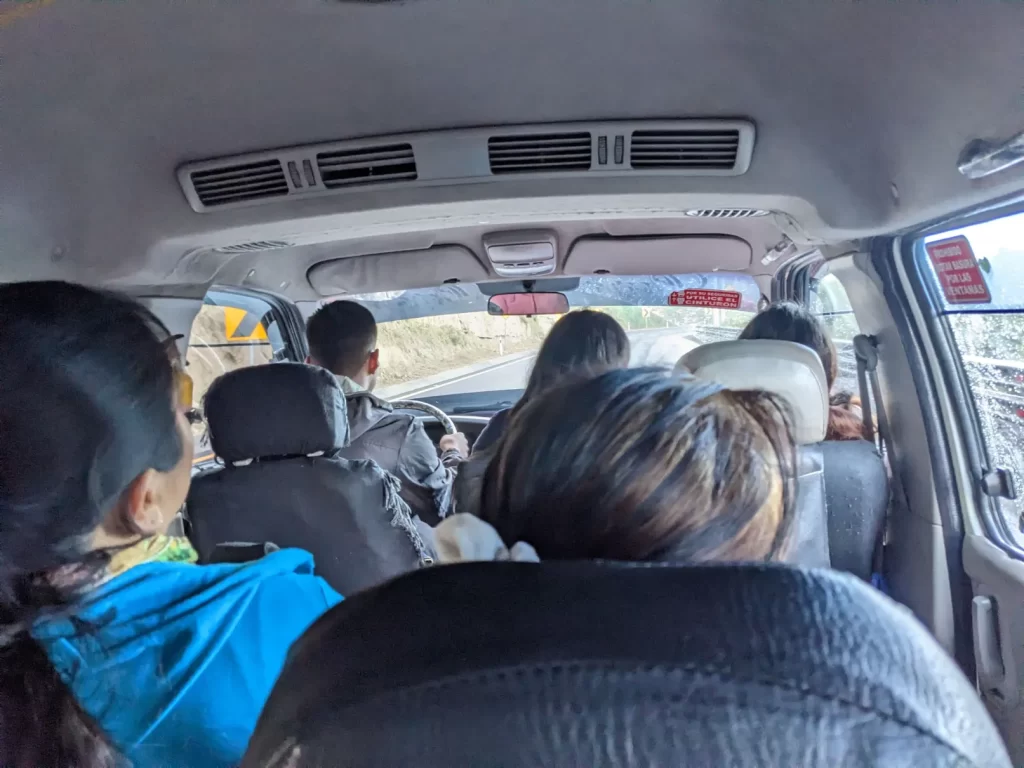
We arrived at the Tulcan Bus Terminal in about 30 minutes.
Once we arrived, bus terminal attendants immediately asked everyone on the collectivo where they were going. We told the attendant “ Quito “, and he walked us to the office which sold tickets for buses to that destination. We went to the office and paid the fare ( $7 USD per ticket) and were directed to the actual bus station where we would get picked up.
Our bus was to leave at 7:30 am, which was in 10 minutes!
We paid the fee to enter the bus station ( $0.25 USD per person ), entered the bus waiting area, and our bus pulled in at 7:30 am sharp.
It was a large, Greyhound-style bus (for those from the USA) with cushy seats and WiFi, much to our surprise. This was a good thing because the route to Quito was 5 hours long!
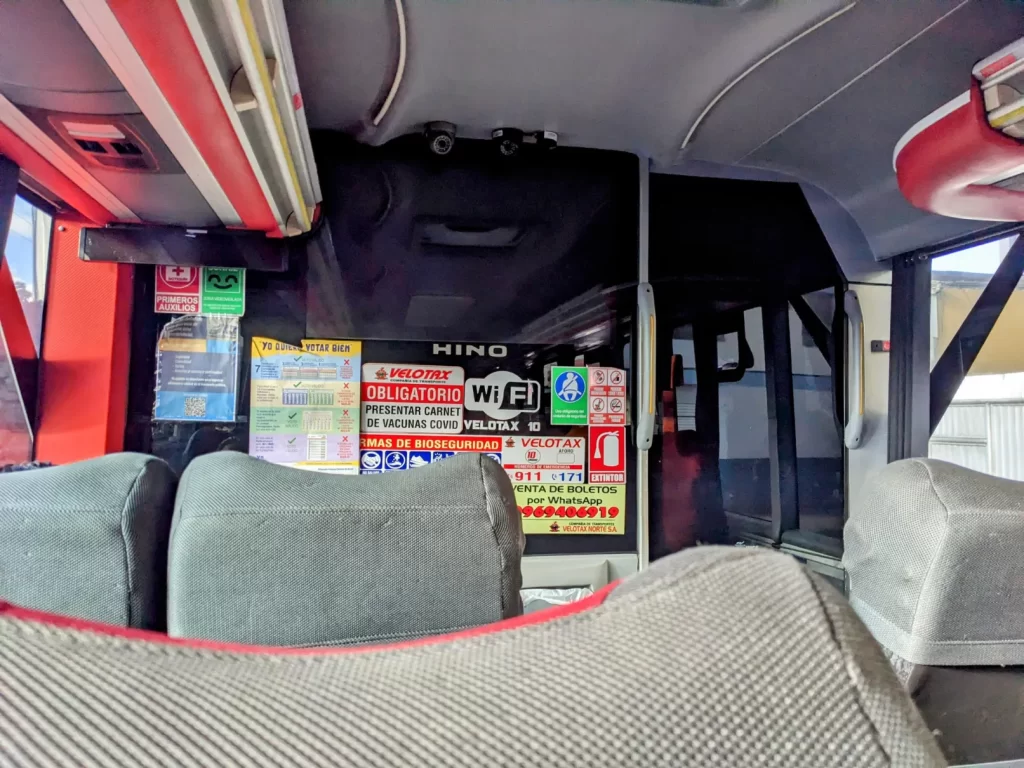
Here is the route our bus took:
The scenery was gorgeous the entire way. The mountain views were striking! And it was impressive how well the driver could make our bus slalom at speed along some EXTREMELY windy roads.
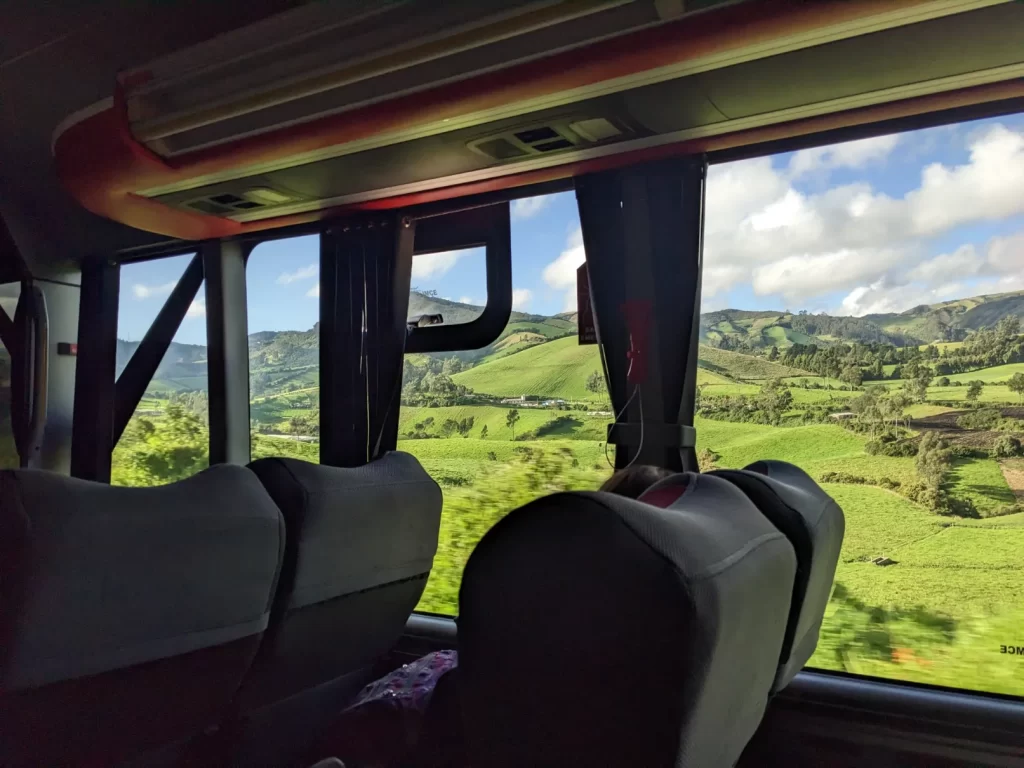
We pulled into the North Quito Bus Terminal ( Google Maps ) at about 12:30 pm. We were in good spirits but were tired. But we were just one 30-minute taxi ride away from our Airbnb in the Pambachupa neighborhood of Quito !
Mercifully, taxi drivers were plentiful at the bus station, and we were quoted a fare of $9 USD for the trip. This was below the cost our Airbnb host suggested was fair ($10 maximum), so we immediately agreed and left for our new apartment.
We will show you our new Quito Airbnb in our next post!
Closing Thoughts on Crossing the Colombia-Ecuador Border
Honestly, Rhonda and I were shocked at how smoothly our two days of travel went. Aside from the initial flight delay (which didn’t affect anything), the entire process went more quickly than we predicted, especially at the border crossing!
23 minutes has to be some sort of land speed record there.
And we never felt unsafe at any point. There were tons of police at the border crossing areas and the transportation industry workers in both Ecuador and Colombia were quick to help us out with a smile.
But if you do plan on copying how we crossed the border, do yourself a favor and cross on a weekday at 6 am!
Until next time…
Thanks for reading!
Leave a comment below and subscribe to get email notifications whenever we post!
Follow Two Travel Turtles on Facebook and Twitter !

Subscribe and never miss a post!
We don’t spam! Read our privacy policy for more info.
Thanks for subscribing to Two Travel Turtles! Check your inbox or spam folder to confirm your subscription.
Check Out These Related Posts:
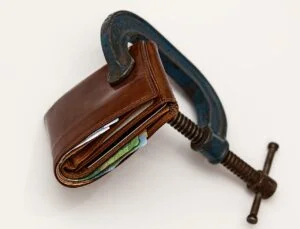
2 thoughts on “ Everything You Need to Know About Crossing the Colombia-Ecuador Border ”
Marvelous!!
And a bit crazy. 🙂
Leave a Comment! Cancel reply
Your email address will not be published. Required fields are marked *
Save my name, email, and website in this browser for the next time I comment.
Subscribe me to Two Travel Turtles!
This site uses Akismet to reduce spam. Learn how your comment data is processed .
Cookies on GOV.UK
We use some essential cookies to make this website work.
We’d like to set additional cookies to understand how you use GOV.UK, remember your settings and improve government services.
We also use cookies set by other sites to help us deliver content from their services.
You have accepted additional cookies. You can change your cookie settings at any time.
You have rejected additional cookies. You can change your cookie settings at any time.
- Passports, travel and living abroad
- Travel abroad
- Foreign travel advice
Entry requirements
This advice reflects the UK government’s understanding of current rules for people travelling on a full ‘British citizen’ passport from the UK, for the most common types of travel.
The authorities in Ecuador set and enforce entry rules. If you’re not sure how these requirements apply to you, contact the Ecuadorean Embassy in the UK .
Documents required to enter via land or river border
If you wish to enter Ecuador via a land and river borders from Peru or Colombia, you must present a criminal record certificate from the country where you lived for the last 5 years. The certificate must be legalised with the Hague Apostille and translated into Spanish if issued in another language. This mandatory requirement was announced on 11 January for implementation with immediate effect.
If you do not have the correct documentation you will be denied entry via the land or river border, and you may have to change your travel plans.
The following people are exempt from the presentation of the criminal record certificate:
- Holders of a valid Ecuadorean visa
- Holders of diplomatic passports
- Children and adolescents under 18
- Victims of human trafficking or those seeking international protection under the Ecuadorean Human Mobility Law.
There are no restrictions in place for anyone flying into Ecuador.
To obtain a UK Police Criminal Record Certificate, check the ACRO website . For information about legalising the document with the Hague apostille check the Foreign, Commonwealth and Development Office’s Legalisation Office website site.
COVID-19 rules
There are no COVID-19 testing or vaccination requirements for travellers entering Ecuador.
If you have COVID-19 symptoms such as high temperature, cough, loss of sense of smell or taste or a skin rash, complete a health declaration form online or when you arrive.
Ecuadorean nationals and foreign residents must have COVID-19 vaccinations.
Travel in Ecuador
You may be asked to wear a face mask in some hospitals, clinics and other medical settings.
See further information on the Ministry of Public Health Twitter account .
Passport validity requirements
Your passport must have an ‘expiry date’ at least 6 months after the date you arrive.
Check with your travel provider that your passport and other travel documents meet requirements. Renew your passport if you need to.
You will be denied entry if you do not have a valid travel document or try to use a passport that has been reported lost or stolen.
Visa requirements
You can travel to Ecuador for up to 90 days in any 12-month period without a visa.
If you plan to stay longer, contact your nearest Ecuadorean Embassy (in Spanish) before travelling.
If you’re already in Ecuador and want to stay longer than 90 days, you can pay to extend your stay (in Spanish) by an extra 90 days. You must apply for an extension before the first 90-day period ends or you could be fined.
If you overstay your visa, you will get a fine when you leave. You will not be allowed to return to Ecuador unless you pay the fine before you leave the country.
For immigration information, see Ecuador Migration .
Applying for a visa
To stay longer (to work or study, or for other reasons), contact the nearest Ecuadorean embassy (in Spanish) before you travel. The Ecuador Ministry of Foreign Affairs has visa application information (in Spanish).
You should get an appointment before visiting the Ministry of Foreign Affairs and Human Mobility (MFA). For general guidance contact: [email protected] or [email protected]
Checks at border control
You may be asked your reason for travel and for evidence of a return or onward journey.
Peru and Colombia land border crossings
If you enter Ecuador via land from Peru or Colombia, you must get an official passport entry stamp showing your arrival date. Sometimes buses do not stop at the border, which can lead to foreign visitors not getting a stamp. You could get a fine or be asked to return to the border. Contact an immigration office as soon as possible.
Galapagos Islands
Tourists can stay in the Galapagos Islands for up to 60 days. To enter Galapagos, you must have:
- evidence of a hotel booking or an invitation letter from your host
- evidence of a return flight to the Ecuadorean mainland
- completed an online Galapagos transit control card at least 24 hours before your flight – you must also keep a copy
- travel health insurance, which is mandatory for foreign tourists
Travelling with children
Leaving ecuador .
Some British children aged 17 and under must have a notarised consent letter (in Spanish) to leave Ecuador, if they are travelling alone or with one parent or legal guardian.
British children must have a notarised letter from parents or guardians not travelling with them if they were born in Ecuador, even if they’re travelling on a British passport, or live in Ecuador.
If they are tourists, British children (or British-Ecuadorean dual nationals) do not need a consent letter.
If one parent is deceased, the other parent must submit the death certificate to an Ecuadorean public notary to get an indefinite notarial permit to travel with the child.
In more complex situations, such as legal disputes, a child will need judicial written permission (‘Autorización de Viaje Judicial’) issued by an Ecuadorian judge (‘Juzgado de la Niñez y Adolescencia’).
Entering Ecuador
Children entering Ecuador with someone other than a parent or legal guardian do not need a consent letter.
Vaccination requirements
At least 8 weeks before your trip, check the vaccinations and certificates you need in TravelHealthPro’s Ecuador guide .
Depending on your circumstances, these may include a yellow fever certificate.
Customs rules
There are strict rules about goods you can take into or out of Ecuador via air and via land . You must declare anything that may be prohibited or subject to tax or duty.
Taking money out of Ecuador
You must declare cash you’re carrying when you leave Ecuador. You will have to pay tax on amounts over 1,350 US dollars.
Related content
Is this page useful.
- Yes this page is useful
- No this page is not useful
Help us improve GOV.UK
Don’t include personal or financial information like your National Insurance number or credit card details.
To help us improve GOV.UK, we’d like to know more about your visit today. We’ll send you a link to a feedback form. It will take only 2 minutes to fill in. Don’t worry we won’t send you spam or share your email address with anyone.
Update April 12, 2024
Information for u.s. citizens in the middle east.
- Travel Advisories |
- Contact Us |
- MyTravelGov |
Find U.S. Embassies & Consulates
Travel.state.gov, congressional liaison, special issuance agency, u.s. passports, international travel, intercountry adoption, international parental child abduction, records and authentications, popular links, travel advisories, mytravelgov, stay connected, legal resources, legal information, info for u.s. law enforcement, replace or certify documents.
Before You Go
Learn About Your Destination
While Abroad
Emergencies
Share this page:
Travel Advisory January 2, 2024
Colombia - level 3: reconsider travel.
Reissued with updates to the country summary.
Reconsider travel due to crime and terrorism . Exercise increased caution due to civil unrest and kidnapping . Some areas have increased risk. Read the entire Travel Advisory.
Do Not Travel to:
- Arauca, Cauca (excluding Popayán), and Norte de Santander departments due to crime and terrorism.
- The Colombia-Venezuela border region due to crime, kidnapping, and risk of detention when crossing into Venezuela from Colombia.
Country Summary: Violent crime, such as homicide, assault, and armed robbery, is widespread. Organized criminal activities, such as extortion, robbery, and kidnapping, are common in some areas.
Terrorist groups and criminal organizations continue operating and carrying out attacks in Colombia. They may attack with little or no warning, targeting transportation hubs, markets/shopping malls, local government facilities, police stations, military facilities, hotels, clubs, restaurants, airports, other public areas, and U.S. government facilities.
Demonstrations occur regularly throughout the country and can be about a variety of political or economic issues. They can shutdown roads and highways, often without prior notice or estimated reopening timelines. Demonstrations and road closures may significantly reduce access to public transportation and may disrupt travel within and between cities. Protests can become violent and can result in fatalities and injuries.
U.S. direct-hire government employees must adhere to the noted restrictions:
- They are not permitted to travel by road between most cities.
- Colombia’s land border areas are off-limits to U.S. government personnel unless specifically authorized.
- They may not use motorcycles.
- They may not hail street taxis or use public buses.
Read the country information page for additional information on travel to Colombia.
If you decide to travel to Colombia:
- Avoid protest areas and crowds.
- Monitor local media for breaking events and adjust your plans based on new information.
- Keep a low profile.
- Be aware of your surroundings.
- Enroll in the Smart Traveler Enrollment Program (STEP) to receive Alerts and make it easier to locate you in an emergency.
- Follow the Department of State on Facebook and Twitter
- Review the Country Security Report for Colombia.
- Prepare a contingency plan for emergency situations. Review the Traveler’s Checklist .
Arauca, Cauca, and Norte de Santander Departments – Level 4: Do Not Travel
Violent crime, including armed robbery and homicide, is widespread. Terrorist groups are active in some parts.
The U.S. government has limited ability to provide emergency services to U.S. citizens as U.S. government-personnel travel to these areas is severely restricted due to security concerns.
Colombia - Venezuela Border – Level 4: Do Not Travel
U.S. citizens are advised not to travel to the border of Colombia and Venezuela. U.S. citizens are at risk of detention when crossing into Venezuela.
The Colombia-Venezuela border is not clearly marked, and U.S. citizens should not go near the border due to the risk of crossing into Venezuela accidentally.
U.S. citizens attempting to enter Venezuela without a visa have been charged with terrorism and other serious crimes and detained for long periods. For more information, see the Venezuela Travel Advisory.
Visit our website for Travel to High-Risk Areas .
Embassy Messages
View Alerts and Messages Archive
Quick Facts
Must be valid at the time of entry and for the duration of stay.
One page required for entry stamp unless enrolled in Migración Automática, a program for frequent travelers.
Not required for stays 90 days or less.
Yellow fever vaccination is required for travelers coming from certain countries or visiting certain national parks.
10,000 USD maximum.
Embassies and Consulates
U.S. Embassy Bogota
Physical Address: Calle 24 Bis No. 48-50, Bogotá, D.C., Colombia Mailing address: Carrera 45 No. 24B-27, Bogotá, D.C. 110111, Colombia Telephone: +(57) (601) 275-2000 Emergency after-hours telephone: +(57) (601) 275-2000 and press 0 Email: [email protected]
U.S. Consular Agency Barranquilla Calle 77B No. 57-141, Suite 511 Centro Empresarial Las Americas 1, Barranquilla, Atlántico, Colombia Telephone: +(57) 605-353-2001 and +(57) 605-369-0149 Emergency after-hours telephone: +(57) (601) 275-4021 Email: [email protected]
For hours and services, please visit the U.S. Embassy Bogota website .
Destination Description
See the Department of State’s website www.state.gov for information on U.S. - Colombia relations.
Entry, Exit and Visa Requirements
Travelers must complete Migración Colombia’s Online Check-Mig Form within 72 hours of boarding an inbound or outbound flight from Colombia. There is no fee to complete the form.
All U.S. citizens who do not also hold Colombian citizenship must present a valid U.S. passport to enter and leave Colombia. U.S. citizens do not need a Colombian visa for a tourist or business stay of 90 days or less, or for cumulative stays of 180 days or less per calendar year. Before your 90-day stay expires, you may request an extension of up to 90 additional days from the Colombian immigration authority ( Migración Colombia ). You will face a fine if you remain in Colombia longer than allowed, and you may not be able to leave Colombia until the fine is paid.
Any traveler entering with a Colombian visa of any type (as opposed to visa-free entry described above) with more than three months’ validity must register the visa at a Migración Colombia office or online within 15 days of arrival in Colombia or face fines. You may be denied entry to Colombia if you do not have a return ticket. Visit the Ministry of Commerce, Industry, and Tourism website for the most current visa information.
Visit the CDC Traveler View website for vaccination information, and the Colombian Ministry of Health website for Yellow Fever vaccination requirements.
Special Entry/Exit Instructions for U.S. Citizens Born in Colombia: All Colombian citizens—regardless of dual citizenship—MUST present a valid, non-expired Colombian passport to enter and exit Colombia. Colombian citizens traveling with non-Colombian passports may be unable to depart the country until they obtain a Colombian passport.
Be aware that any person born in Colombia or of Colombian parentage may be considered a Colombian citizen, even if never documented as such.
Be aware as well that all U.S. citizens, regardless of dual citizenship, must present a valid U.S. passport upon returning to the United States. Persons who are both U.S. and Colombian citizens MUST travel between these countries with both passports, presenting the Colombian passport upon departing Colombia and the U.S. passport upon arrival in the United States.
Additional Exit Requirements for Minors: To prevent international child abduction, Colombia has implemented special exit procedures for Colombian children under 18 (including dual nationals) who depart the country alone, without both parents, or without a legal guardian. For detailed information regarding exit requirements for minors with Colombian nationality please visit Migración Colombia's website (in Spanish only).
Lost or Stolen Passport: If your U.S. passport is lost or stolen in Colombia, you must obtain a new one before leaving the country. You can report the loss or theft on the Colombian National Police website .
The U.S. Department of State is unaware of any HIV/AIDS entry restrictions for visitors to or foreign residents of Colombia.
Find information on dual nationality , prevention of international child abduction , and customs regulations on our websites.
Safety and Security
Terrorism : Terrorist groups and those inspired by such organizations are intent on attacking U.S. citizens abroad. Terrorists are increasingly using less sophisticated methods of attack – including knives, firearms, and vehicles – to more effectively target crowds. Frequently, their aim is focused on unprotected or vulnerable targets, such as:
- High-profile public events (sporting events, political rallies, demonstrations, holiday events, celebratory gatherings, etc.)
- Hotels, clubs, and restaurants frequented by tourists
- Places of worship
- Shopping malls and markets
- Public transportation systems (including subways, buses, trains, and scheduled commercial flights)
Terrorist groups and criminal organizations continue operating and carrying out attacks in Colombia.
For more information, see our Terrorism page.
Crime : Crimes and scams against tourists, and those perceived to be wealthy, are common and well-coordinated in urban areas, including in affluent neighborhoods. Firearms and knives are prevalent in Colombia and often used in muggings and robberies under the threat of violence. Drive-by motorcyclist snatchings of cell phones, bags, and valuables are extremely common. Victims are often identified well in advance of the robbery based on visible jewelry, high value wristwatches, and general attire while in public places such as shopping malls, restaurants, and airports.
Narco-trafficking groups, including the Clan del Golfo frequently engage in violence against civilians and security forces.
Dating App Robberies/Drugging/Homicides: Criminals use dating apps to lure victims to meet in places such as hotels, restaurants, and bars, and then later assault and rob them. Numerous U.S. citizens in Colombia have been drugged, robbed, and even killed by their Colombian dates. You should be cautious if using dating apps in Colombia. If meeting with a stranger, you should strongly consider meeting only in public places and avoiding isolated locations, such as residences or hotel rooms, where crimes are most likely to occur. Tell a friend or family member of your plans, including where you are going, details of the person you are meeting, and the app you used to meet them.
ATMs : There have been instances of fraudulent charges or withdrawals from accounts due to “skimmed” cards. If you choose to use credit or debit cards, you should regularly check your account to ensure there are no unauthorized transactions. Travelers should limit the amount of cash they carry in public, exercise caution when withdrawing cash from ATMs, and avoid ATMs located on the street. ATMs inside shopping malls or other protected locations are preferable.
Taxis : U.S. government employees are prohibited from hailing taxis on the street due to the risk of assault or robbery. U.S. citizens have been killed during robberies while using taxis. Use a dispatch service or cell phone app whenever possible.
Disabling Drugs : The Embassy receives regular reports of criminals using drugs to temporarily incapacitate unsuspecting victims and then rob or assault them. Scopolamine, a fast-acting incapacitating drug, is often surreptitiously applied to food, drinks, and hand sanitizer vials by criminals to rob or assault their victims. Victims of scopolamine-related crimes are often targeted in bars, night clubs, or through dating apps. Avoid leaving food or drinks unattended at a bar or restaurant, and refuse offers of something to eat or drink from a stranger.
Ayahuasca/Hallucinogens: Traditional hallucinogens, often referred to as ayahuasca, can be marketed to tourists as “spiritual cleansing,” and typically contain dimethyltryptamine (DMT), a strong psychedelic that is illegal in the United States and many other countries. Risks to hallucinogen users while intoxicated include robbery, assault, illness, or death. People claiming to be shamans or spiritual practitioners are neither licensed nor regulated.
Demonstrations : Protests and demonstrations occur frequently, particularly in Bogota. They may take place in response to political or economic issues, on politically significant holidays, and during international events.
- Demonstrations can be unpredictable; avoid areas around protests and demonstrations.
- Check local media for updates and traffic advisories.
International Financial Scams : See the Department of State and the FBI pages for information.
Internet romance and financial scams are prevalent in Colombia. Scams are often initiated through Internet postings/profiles or by unsolicited emails and letters. Scammers almost always pose as U.S. citizens who have no one else to turn to for help. Common scams include:
- Romance/Online dating
- Money transfers
- Lucrative sales
- Gold purchase
- Contracts with promises of large commissions
- Grandparent/Relative targeting
- Free Trip/Luggage
- Inheritance notices
- Work permits/job offers
- Bank overpayments
- Posing as U.S. government officials soliciting payment for services.
Victims of Crime: U.S. citizen victims of sexual assault are encouraged to contact the U.S. Embassy for assistance. Report crimes to the local police by dialing 123 and contact the U.S. Embassy at +57 (601) 275-2000 or +57 (601) 275-4021 after hours. Remember that local authorities are responsible for investigating and prosecuting crimes.
See our webpage on help for U.S. victims of crime overseas .
- Help you find appropriate medical care.
- Assist you in reporting a crime to the police.
- Contact relatives or friends with your written consent.
- Provide general information regarding the victim’s role during the local investigation and following its conclusion.
- Provide a list of local attorneys.
- Provide our information on victim’s compensation programs in the United States.
- Provide an emergency loan for repatriation to the United States and/or limited medical support in cases of destitution.
- Help you find accommodation and arrange flights home.
- Replace a stolen or lost passport.
Domestic Violence: U.S. citizen victims of domestic violence are encouraged to contact the Embassy for assistance. Help in domestic violence situations is available, in Spanish, by calling 155 (*155 from a cell phone).
Tourism : The tourism industry is unevenly regulated, and safety inspections for equipment and facilities are uncommon. Hazardous areas/activities are not always identified with appropriate signage, and staff may not be trained or certified by the government or by recognized authorities. In the event of an injury, adequate medical treatment may only be available in or near major cities. First responders may only be able to provide basic medical treatment and may be unable to access areas outside of major cities. U.S. citizens are encouraged to purchase medical evacuation insurance .
Venezuelan Border : The U.S. Department of State has categorized Venezuela as Level 4: Do Not Travel due to crime, civil unrest, poor health infrastructure, kidnapping, and the arrest and detention of U.S. citizens without due process or fair trial guarantees. U.S. citizens are at risk of detention when crossing into Venezuela from Colombia. The Colombia-Venezuela border is not clearly marked, and U.S. citizens should not go near the border due to the risk of crossing into Venezuela accidentally and being detained for illegal entry. If you still choose to travel to Venezuela, do not attempt to enter Venezuela without a visa. Visas are not available upon arrival. U.S. citizens attempting to enter Venezuela without a visa have been charged with terrorism and other serious crimes and detained for long periods. The Maduro regime does not notify the U.S. government of the detention of U.S. citizens and the U.S. government is not granted access to those citizens. The U.S. government has extremely limited ability to provide emergency services to U.S. citizens in Venezuela.
Local Laws & Special Circumstances
Criminal Penalties : You are subject to local laws. If you violate local laws, even unknowingly, you may be arrested, imprisoned, or expelled.
Individuals establishing a business or practicing a profession that requires additional permits or licensing should seek information from the competent local authorities prior to practicing or operating a business.
Customs Regulations : If you enter or exit Colombia possessing cash or other financial instruments worth more than $10,000USD, you must declare them and be able to prove the legal source of the funds. The Embassy has received reports of customs officials confiscating high-value jewelry that was not declared upon entry.
Colombian law prohibits tourists and business travelers from bringing firearms and ammunition into Colombia. Colombian law also restricts the importation of plants and animals (and some related products).
Artifacts : Colombian law forbids the export of pre-Columbian objects and other artifacts protected by cultural patrimony statutes. U.S. customs officials are obliged to seize pre-Columbian objects and certain colonial religious artwork brought into the United States.
Furthermore, some laws are also prosecutable in the United States, regardless of local law. For examples, see our website on crimes against minors abroad and the Department of Justice website.
Arrest Notification : If you are arrested or detained, ask police to notify the U.S. Embassy immediately. See our webpage for further information.
Penalties for possessing, using, or trafficking in illegal drugs in Colombia are severe, and convicted offenders can expect long pre-trial detention and lengthy prison sentences under harsh conditions. Colombian law may require that released offenders serve a lengthy period of parole in-country, during which the offender is given no housing and may lack permission to work.
Colombia uses comprehensive screening procedures to detect narcotics smuggling at its international airports. Travelers are occasionally questioned, searched, fingerprinted, and/or asked to submit to an abdominal X-ray upon arrival or departure. Most airport inspectors do not speak English.
Counterfeit and Pirated Goods : Although counterfeit and pirated goods are prevalent in many countries, they may still be illegal according to local laws. You may also pay fines or have to give them up if you bring them back to the United States. See the U.S. Department of Justice website for more information.
Faith-Based Travelers : See the following webpages for details:
- Faith-Based Travel Information
- International Religious Freedom Report – see country reports
- Human Rights Report – see country reports
- Hajj Fact Sheet for Travelers
- Best Practices for Volunteering Abroad
LGBTQI+ Travelers : Colombia has one of the strongest legal frameworks in Latin America defending the rights of LGBTQI+ people; however, in practice protections remain a long way from full enforcement and harassment persists, especially in rural areas. In many parts of Colombia, violence against trans people exceeds levels of violence against any other members of the LGBTQI+ community. Criminals do utilize dating apps to target potential victims of theft, so travelers should use caution on such apps. Certain regions, especially in rural areas, experience higher instances of harassment/violence against LGBTQI+ communities. In 2022, there was an uptick of homicides specifically targeting gay men in Medellín. LGBTQI+ associated and friendly establishments exist mostly in metropolitan areas, especially Cartagena, Medellin, and Bogota.
See our LGBTQI+ Travel Information page and section 6 of our Human Rights report for further details.
Travelers with Disabilities : The law in Colombia prohibits discrimination against persons with physical or mental disabilities, but the law is not fully enforced. Social acceptance of persons with disabilities is not as prevalent as in the United States. Many public places and transportation are not adapted to accommodate the needs of persons with disabilities. The most common types of accessible facilities may include restrooms, ramps, and elevators. Expect accessibility to be limited in public transportation, lodging, communication/information, and general infrastructure, including sidewalks, intersections, buses, and taxis. There is a significant difference between the capital (and other large cities) and the rest of the country.
Repair and replacement parts for aids/equipment/devices are available. Sign language interpreters or personal assistants are available for hire.
Students : See our Students Abroad page and FBI travel tips .
Women Travelers : See our travel tips for Women Travelers .
Cruise Ship Passengers : See our travel tips for Cruise Ship Passengers .
For emergency services in Colombia, dial 123 from any mobile phone or land line.
Ambulance services are available in larger cities, but training and availability of emergency responders may be below U.S. standards. Injured or seriously ill travelers may prefer to take a taxi or private vehicle to the nearest major hospital rather than wait for an ambulance.
We do not pay medical bills . Be aware that U.S. Medicare/Medicaid does not apply overseas. Most hospitals and doctors overseas do not accept U.S. health insurance.
Medical Insurance : Make sure your health insurance plan provides coverage overseas. Most care providers overseas only accept cash payments. See our webpage for more information on insurance coverage overseas. Visit the U.S. Centers for Disease Control and Prevention website for more information on the type of insurance you should consider before you travel overseas.
We strongly recommend supplemental insurance to cover medical evacuation.
Always carry your prescription medication in original packaging with your doctor’s prescription. Travelers can check with the Embassy of Colombia in the United States to ensure the medication is legal in Colombia.
Vaccinations : Be up-to-date on all vaccinations recommended by the U.S. Centers for Disease Control and Prevention. Visit the CDC Traveler View website for vaccination information, and the Colombia Ministry of Health website for Yellow Fever vaccination requirements. Childhood vaccinations are required by Colombian law for children ages six and under. Visit the Ministry for Health and Public Safety website for a list of required childhood vaccinations.
Further Health Information :
- World Health Organization
- U.S. Centers for Disease Control and Prevention
Air Quality : Visit AirNow Department of State for information on air quality at U.S. Embassies and Consulates.
The U.S. Embassy maintains a list of doctors and hospitals . We do not endorse or recommend any specific medical provider or clinic.
Health Facilities in General :
- Adequate health facilities are available throughout the country, but health care in rural areas may be below U.S. standards.
- Hospitals and doctors often require payment upfront prior to service or admission. Credit card payment is frequently, but not always, available.
- Medical staff may speak little or no English.
- Patients bear all costs for transfer to or between hospitals.
- Psychological and psychiatric services are limited, even in the larger cities, with hospital-based care only available through government institutions.
Medical Tourism and Elective Surgery :
- U.S. citizens have suffered serious complications or died during or after having cosmetic or other elective surgery.
- Medical tourism is a rapidly growing industry. People seeking health care overseas should understand that medical systems operate differently from those in the United States and are not subject to the same rules and regulations. Anyone interested in traveling for medical purposes should consult with their local physician before traveling and visit the U.S. Centers for Disease Control and Prevention website for more information on Medical Tourism.
- Visit the U.S. Centers for Disease Control and Prevention website for information on medical tourism, the risks of medical tourism, and what you can do to prepare before traveling to Colombia.
- We strongly recommend supplemental insurance to cover medical evacuation in the event of unforeseen medical complications or repatriation in the case of untimely death.
- Your legal options in cases of malpractice are very limited in Colombia.
- Although Colombia has many elective/cosmetic surgery facilities that are on par with those found in the United States, the quality of care varies widely. If you plan to undergo surgery in Colombia, carefully research the doctor and recovery facility you plan to use. Make sure that emergency medical facilities are available, and that professionals are accredited and qualified. Share all health information (e.g. medical conditions, medications, allergies) with your doctor before surgery.
Pharmaceuticals :
- Exercise caution when purchasing medication overseas. Pharmaceuticals, both over the counter and requiring prescription in the United States, are often readily available for purchase with little controls. Counterfeit medication is common and may prove to be ineffective, the wrong strength, or contain dangerous ingredients. Medication should be purchased in consultation with a medical professional and from reputable establishments.
- U.S. Customs and Border Protection and the Food and Drug Administration are responsible for rules governing the transport of medication back to the United States. Medication purchased abroad must meet their requirements to be legally brought back into the United States. Medication should be for personal use and must be approved for usage in the United States. Please visit the U.S. Customs and Border Protection and the Food and Drug Administration websites for more information.
- Colombia does not allow the sale of certain psychiatric medications. Travelers should carry a sufficient supply for their trips. Please review the Colombian government’s open data website for drug unavailability.
Assisted Reproductive Technology and Surrogacy :
- If you are considering traveling to Colombia to have a child through the use of assisted reproductive technology (ART) or surrogacy, please see our ART and Surrogacy Abroad page .
- Surrogacy is currently neither prohibited nor permitted under Colombian law. Although surrogacy agencies/clinics claim surrogacy is legal in Colombia, there is no legal framework for foreigners or same-sex couples to pursue surrogacy. As a result, surrogacy agreements between foreign or same sex intending parents and gestational mothers may not be enforced by Colombian courts.
Water Quality :
- In rural areas, tap water may not be potable. Bottled water and beverages are generally safe, although you should be aware that many restaurants and hotels serve tap water unless bottled water is specifically requested. Be aware that ice for drinks may be made using tap water.
Altitude :
- Many cities in Colombia, such as Bogota, are at high altitude. Be aware of the symptoms of altitude sickness and take precautions before you travel. Visit the U.S. Centers for Disease Control and Prevention website for more information about Travel to High Altitudes .
Adventure Travel :
- Visit the U.S. Centers for Disease Control and Prevention website for more information about Adventure Travel .
General Health :
The following diseases are prevalent:
- Chikungunya
- Yellow Fever
In Chocó, Nariño, and Córdoba, use the U.S. Centers for Disease Control and Prevention recommended mosquito repellents, and sleep under insecticide-impregnated mosquito nets. Chemoprophylaxis is recommended for all travelers in the Amazon region, even for short stays.
HIV/AIDS: Travelers should bring medication sufficient for their entire stay.
Visit the U.S. Centers for Disease Control and Prevention website for more information about Resources for Travelers regarding specific issues in Colombia.
Air Quality :
- Air pollution is a problem in several major cities in Colombia. Consider the impact smog and heavy particulate pollution may have on you and consult your doctor before traveling if necessary.
- Infants, children, and teens
- People over 65 years of age
- People with lung disease such as asthma and chronic obstructive pulmonary disease (COPD), which includes chronic bronchitis and emphysema
- People with heart disease or diabetes
- People who work or are active outdoors
Travel and Transportation
Road Conditions and Safety : Due to the security environment in Colombia and poor infrastructure, U.S. government employees and their families are not permitted to travel by road between most major cities. They also cannot use inter-city or intra-city bus transportation or travel by road outside urban areas at night. Follow these same precautions.
Road travel in Colombia can be dangerous, especially at night. Some roads are poorly maintained, or vulnerable to heavy rains and mudslides. Mountain roads may lack safety features such as crash barriers or guard rails, and conditions are frequently made more treacherous by heavy fog. Highways are often unmarked and unlit, and do not have signs indicating destinations. Slow-moving buses and trucks frequently stop in the middle of the road unexpectedly. In the countryside, livestock is often herded along roads or left to graze on roadsides. Due to a lack of sidewalks, roads are also used by pedestrians.
The use of motorcycles and bicycles is widespread throughout Colombia. U.S. government employees may not use motorcycles because of security concerns.
Traffic Laws : Traffic laws are often ignored and rarely enforced, creating dangerous conditions for drivers and pedestrians. Seat belts are mandatory for all passengers in a private vehicle. Car seats are mandatory for children, and a child under ten years old is not permitted to ride in the front seat. It is against the law to talk on a cellular phone while driving.
If you are involved in an accident, you MUST remain at the scene without moving your vehicle until the authorities arrive. This rule is strictly enforced and moving a vehicle or leaving the scene of an accident may constitute an admission of guilt under Colombian law.
Public Transportation : Do not hail taxis on the street. U.S. government employees may not hail street taxis or use public transportation in Colombia because of security concerns. U.S. citizens have been killed during robberies while using taxis. Use a dispatch service or transportation app whenever possible.
See our Road Safety page for more information. Visit the website of the Colombia national authority responsible for road safety, the Instituto Nacional de Vias .
Aviation Safety Oversight : The U.S. Federal Aviation Administration (FAA) has assessed the government of Colombia’s Civil Aviation Authority as being in compliance with International Civil Aviation Organization (ICAO) aviation safety standards for oversight of Colombia’s air carrier operations. Further information may be found on the FAA’s safety assessment page .
Maritime Travel : Mariners planning travel to Colombia should also check for U.S. maritime advisories and alerts . Information may also be posted to the U.S. Coast Guard homeport website and the NGA broadcast warnings .
Tourist Vessels : Exercise caution when embarked on small tourist boats off the northern coast between Cartagena and the nearby islands. During the months of December and January, the seas off the northern coast can be dangerous for small boats. U.S. citizens have died in boating accidents. Check for lifejackets and safety equipment before boarding a tourist vessel.
For additional travel information
- Enroll in the Smart Traveler Enrollment Program (STEP) to receive security messages and make it easier to locate you in an emergency.
- Call us in Washington, D.C. at 1-888-407-4747 (toll-free in the United States and Canada) or 1-202-501-4444 (from all other countries) from 8:00 a.m. to 8:00 p.m., Eastern Standard Time, Monday through Friday (except U.S. federal holidays).
- See the State Department’s travel website for the Worldwide Caution and Travel Advisories .
- Follow us on Twitter and Facebook .
- See traveling safely abroad for useful travel tips.
Review information about International Parental Child Abduction in Colombia . For additional IPCA-related information, please see the International Child Abduction Prevention and Return Act ( ICAPRA ) report.
Travel Advisory Levels
Assistance for u.s. citizens, colombia map, learn about your destination, enroll in step.

Subscribe to get up-to-date safety and security information and help us reach you in an emergency abroad.
Recommended Web Browsers: Microsoft Edge or Google Chrome.
Check passport expiration dates carefully for all travelers! Children’s passports are issued for 5 years, adult passports for 10 years.
Afghanistan
Antigua and Barbuda
Bonaire, Sint Eustatius, and Saba
Bosnia and Herzegovina
British Virgin Islands
Burkina Faso
Burma (Myanmar)
Cayman Islands
Central African Republic
Cote d Ivoire
Curaçao
Czech Republic
Democratic Republic of the Congo
Dominican Republic
El Salvador
Equatorial Guinea
Eswatini (Swaziland)
Falkland Islands
France (includes Monaco)
French Guiana
French Polynesia
French West Indies
Guadeloupe, Martinique, Saint Martin, and Saint Barthélemy (French West Indies)
Guinea-Bissau
Isle of Man
Israel, The West Bank and Gaza
Liechtenstein
Marshall Islands
Netherlands
New Caledonia
New Zealand
North Korea (Democratic People's Republic of Korea)
Papua New Guinea
Philippines
Republic of North Macedonia
Republic of the Congo
Saint Kitts and Nevis
Saint Lucia
Saint Vincent and the Grenadines
Sao Tome and Principe
Saudi Arabia
Sierra Leone
Sint Maarten
Solomon Islands
South Africa
South Korea
South Sudan
Switzerland
The Bahamas
Timor-Leste
Trinidad and Tobago
Turkmenistan
Turks and Caicos Islands
United Arab Emirates
United Kingdom
Vatican City (Holy See)
External Link
You are about to leave travel.state.gov for an external website that is not maintained by the U.S. Department of State.
Links to external websites are provided as a convenience and should not be construed as an endorsement by the U.S. Department of State of the views or products contained therein. If you wish to remain on travel.state.gov, click the "cancel" message.
You are about to visit:
![travel from colombia to ecuador AWW Media [US]](https://img-s-msn-com.akamaized.net/tenant/amp/entityid/BB1kdTYO.img)
AWW Media [US]
15 Small Towns in South America Everyone Wants to Visit
Posted: May 6, 2024 | Last updated: May 6, 2024
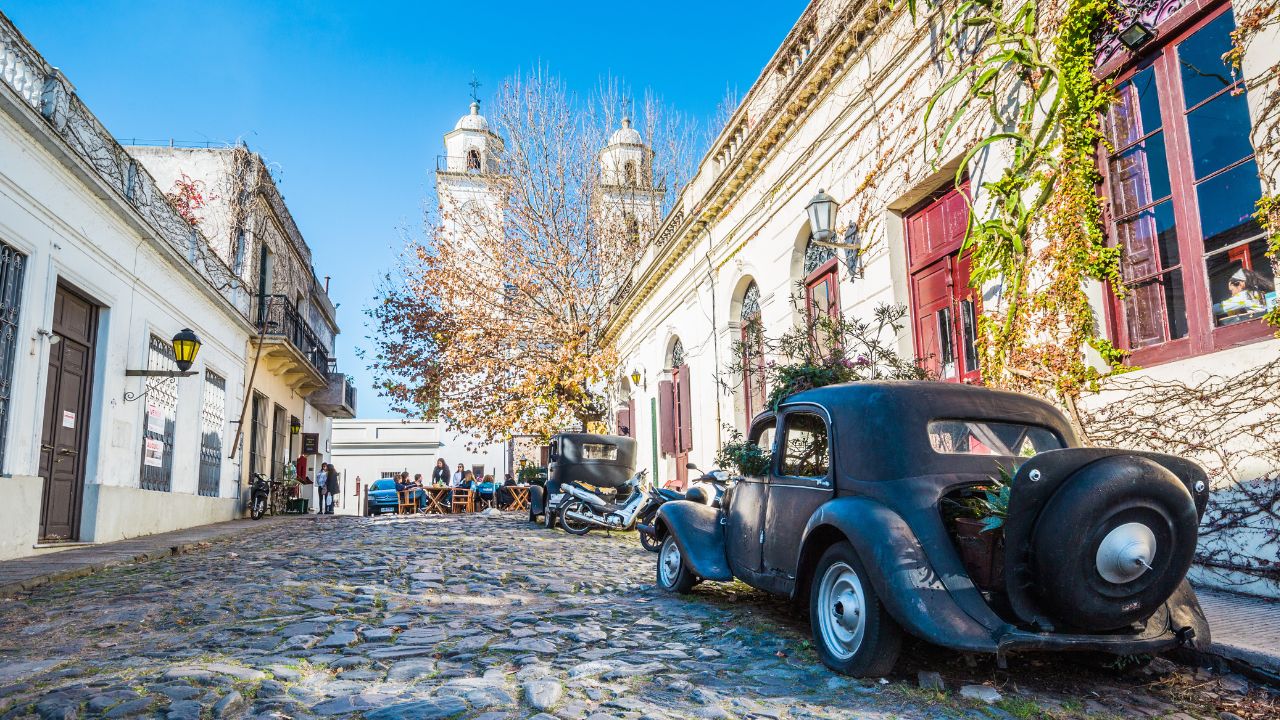
Many of the backpacking routes across South America hit the biggest cities in the region’s most popular destinations, including cities like Medellin in Colombia, Buenos Aires in Argentina, and Quito in Ecuador. But what of the smaller and more charming towns and villages along the way? These are the 15 most beautiful and impressive small towns in South America to add to your travel itinerary.
Colonia del Sacramento, Uruguay
Located along the Rio de la Plata and just a short ferry ride from Buenos Aires, Colonia de Sacramento, Uruguay is one of the most popular destinations for visitors in this tiny South American country. Strolling through its historic district, visitors can enjoy the countless eclectic shops, art galleries, and quaint cafes of this UNESCO World Heritage Site for a glimpse into Uruguay’s rich past.
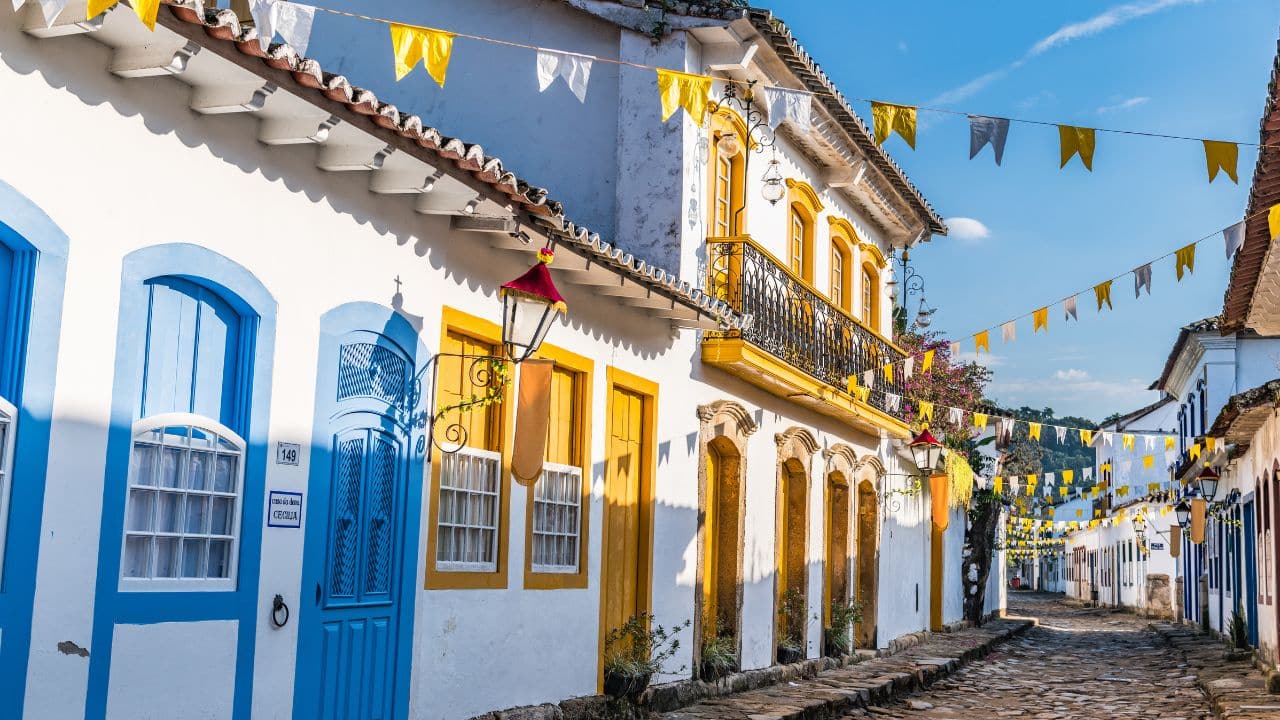
Paraty, Brazil
The small town of Paraty offers more than just historic charm: it’s also a gateway to Brazil’s coastal forests, where travelers can embark on eco-tours, waterfall hikes, and boat trips to secluded islands. With its picturesque cobblestone streets and colorful colonial buildings, Paraty beckons travelers with all it has to offer.
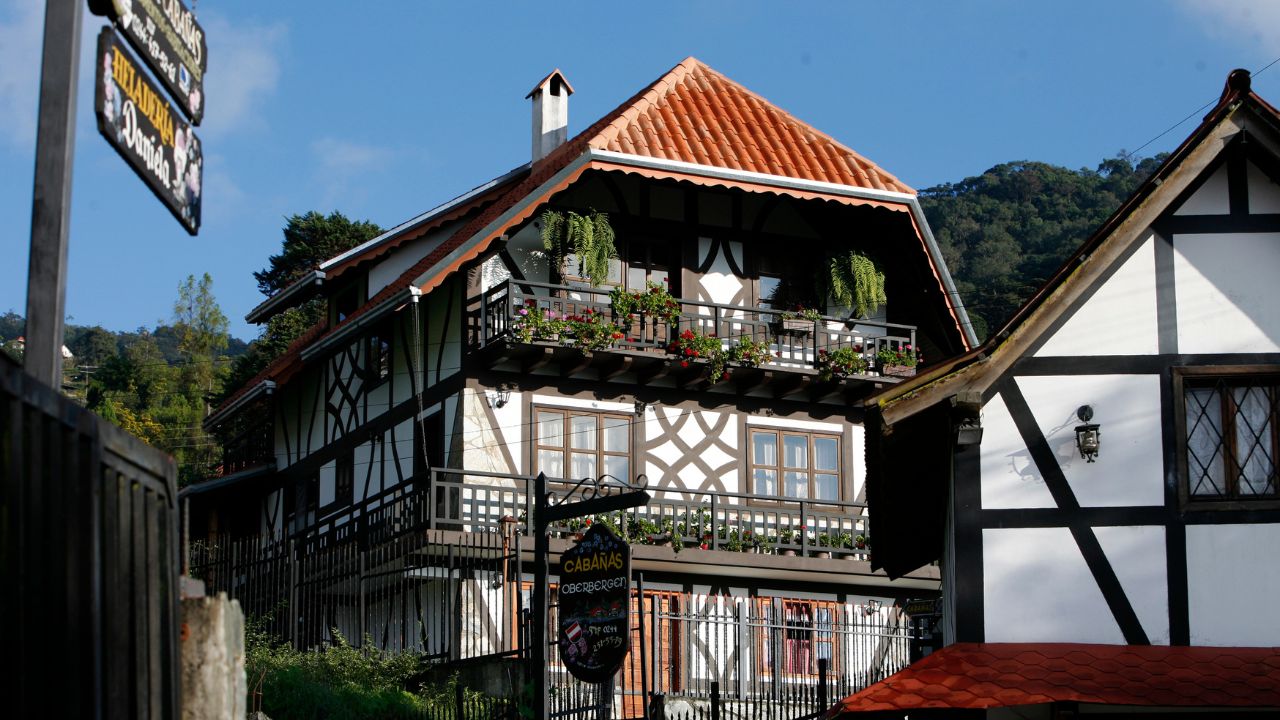
Colonia Tovar, Venezuela
What feels like a slice of Germany in Venezuela, the town of Colonia Tovar enchants with its Alpine-style architecture, beautiful mountain setting, and even traditional beer gardens. Founded by a group of 390 immigrants from Germany, the town still retains much of its traditional German culinary and cultural offerings.
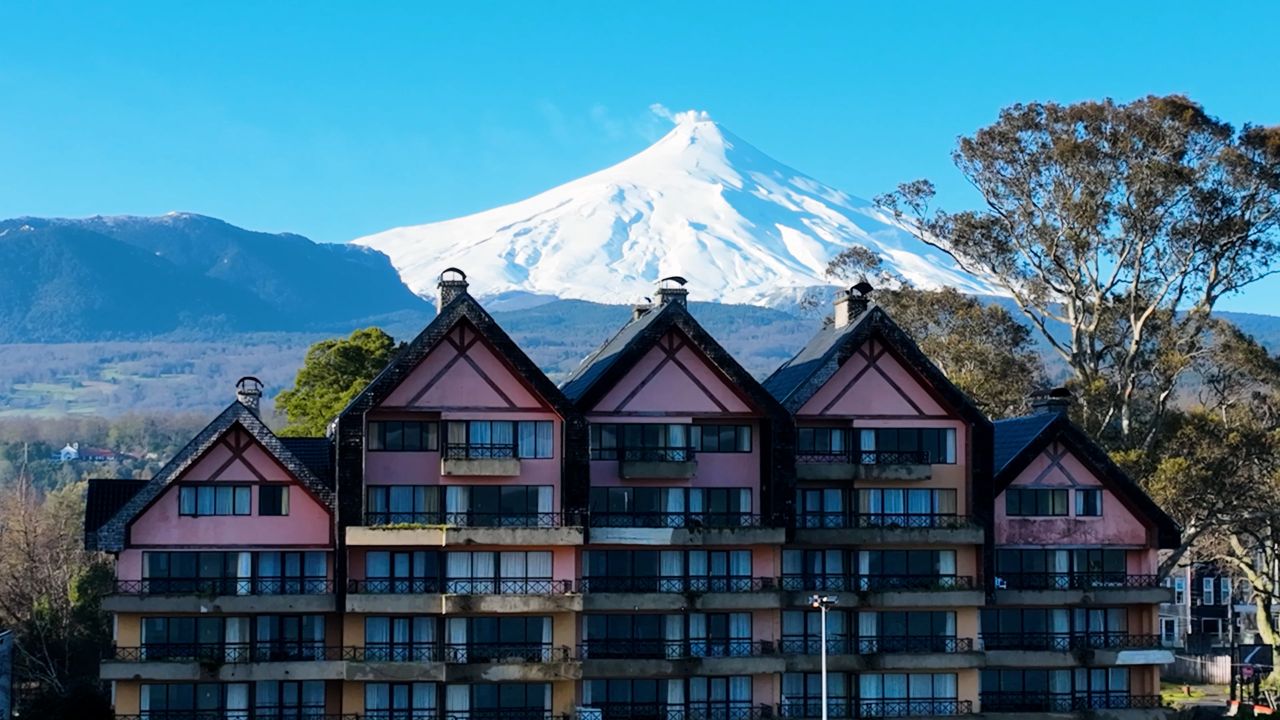
Pucón, Chile
Travelers to the lakeside town of Pucón can unwind in the town’s thermal hot springsthat sit in the shadows of the towering Villarica volcano. Located in the heart of Chile’s stunning lakes district, Pucón is a mecca for adventure enthusiasts, offering thrilling outdoor activities and natural beauty.

Cafayate, Argentina
Mendoza is the undeniable center of Argentina’s increasingly rich wine industry, though the vineyards of Cafayate aren’t bad, either. Beyond its vines, the town offers opportunities to explore nearby geological wonders such as the Quebrada de las Conchas, where vibrant rock formations paint a surreal landscape, providing a glimpse into the region’s geological past.

Villa La Angostura, Argentina
Surrounded by the Andes and framed by pristine lakes, Villa La Angostura invites visitors in this part of central Argentina to indulge in outdoor pursuits from hiking and skiing to simply soaking in its serene beauty. Enjoy some artisanal chocolate at local shops and boutique stores, or local gourmet flavors at the restaurants that line its streets.

Punta del Diablo, Uruguay
The beach town of Punta del Diablo, Uruguay charms with its rugged coastline, sandy shores, and relaxed atmosphere. The town maintains a vibrant, bohemian vibe, coming alive at night with beach bonfires, live music, and cultural events under starry skies.
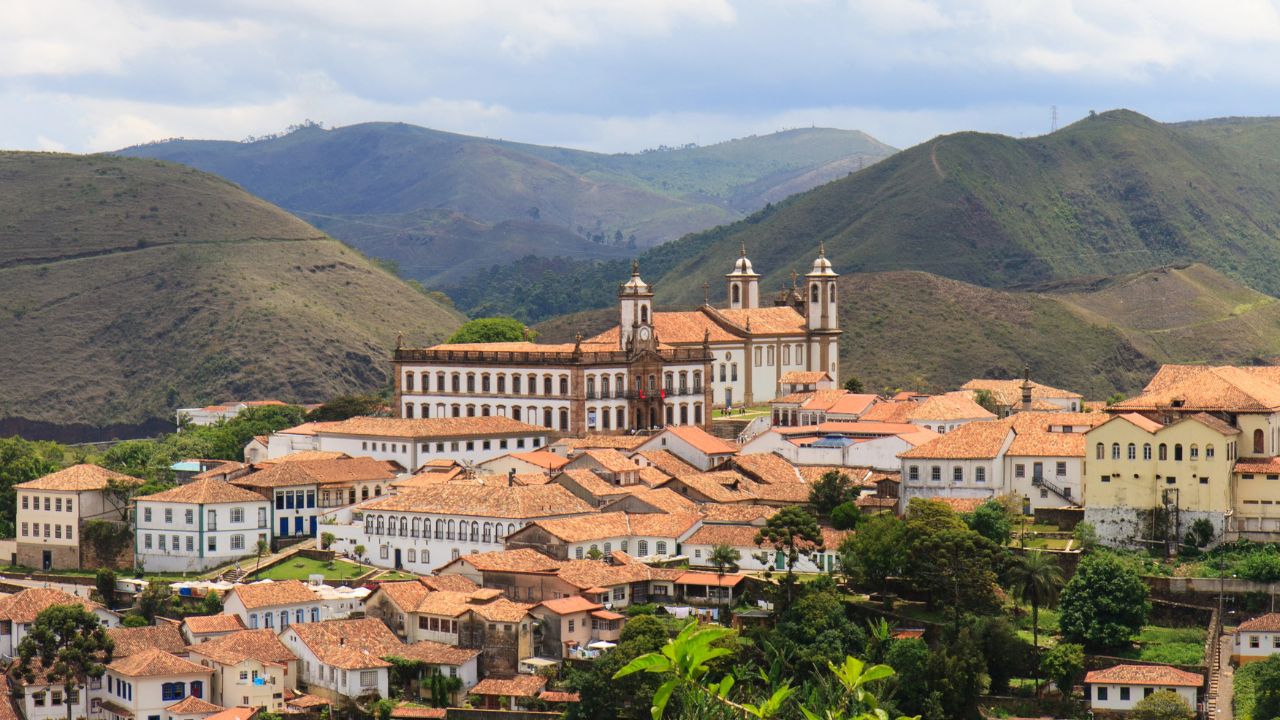
Ouro Preto, Brazil
Ouro Preto, Brazil enchants with its one-of-a-kind Baroque architecture, its rich if troubled history of gold mining having brought significant wealth to the region. Considered a UNESCO World Heritage Site, Ouro Preto has numerous artisan workshops and museums that offer insight into Brazil’s colonial history and long tradition of craftsmanship using the area’s most famous precious metal.
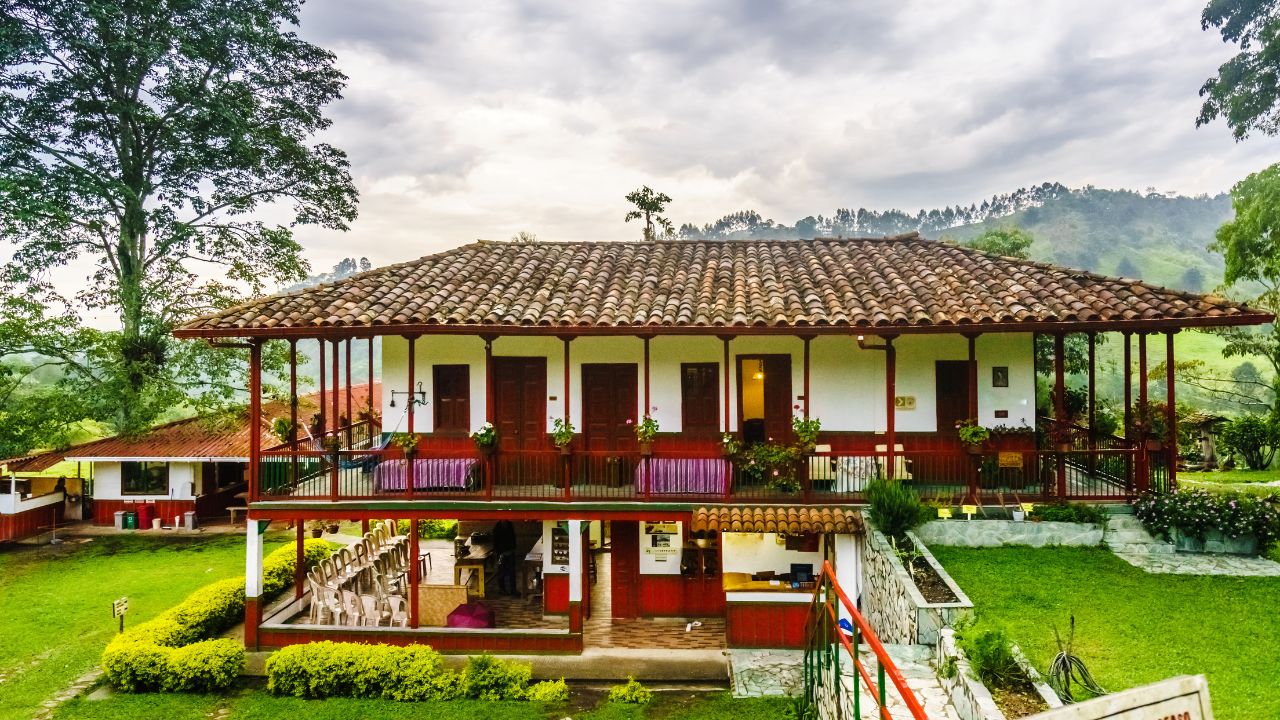
Salento, Colombia
Salento, Colombia is one of several charming towns in the heart of Colombia’s famous Eje Cafetero, the country’s coffee-producing heart. Visitors can embark on horseback riding adventures through verdant valleys and surrounding cloud forests before settling in for an overnight at one of the area’s many coffee plantations turned bed and breakfasts.
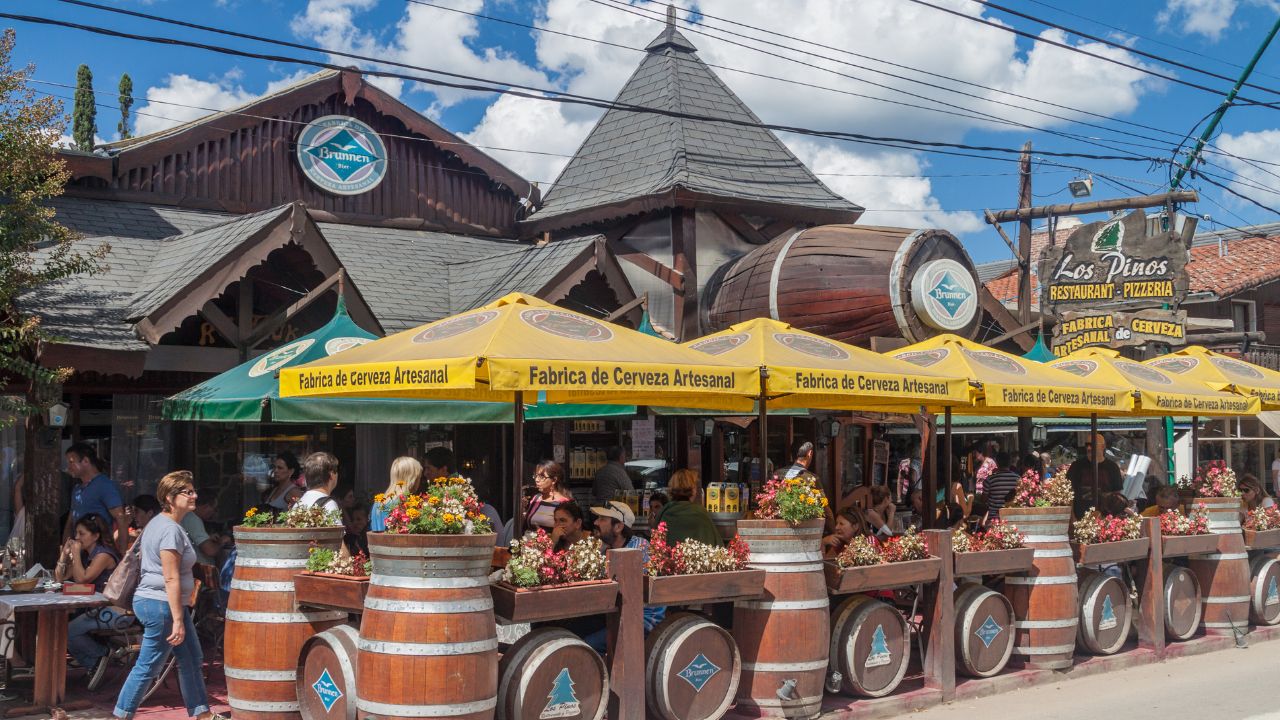
Villa General Belgrano, Argentina
Famous for its Oktoberfest celebrations, Villa General Belgrano exudes Bavarian charm with its Alpine-style buildings, beer gardens, and traditional festivals. The town’s annual beer festival transforms its streets into a lively carnival of music and dancing, drawing beer enthusiasts and revelers from far and wide.
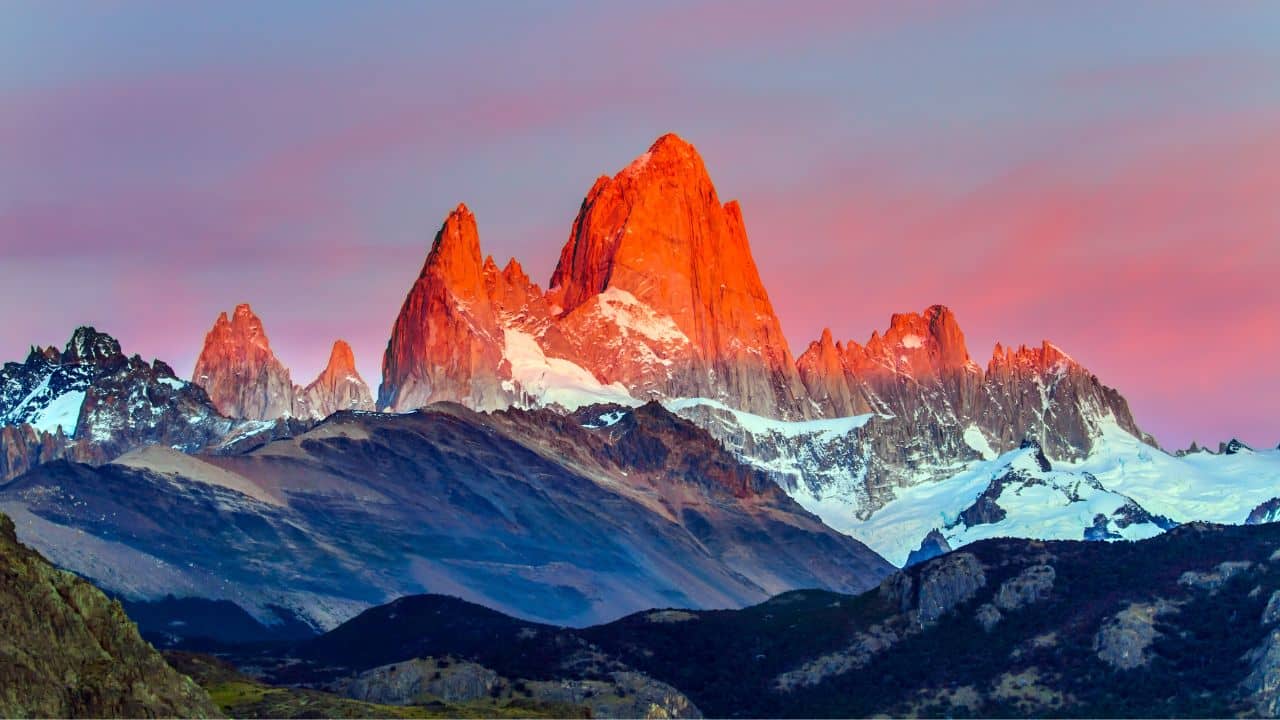
El Chaltén, Argentina
The trekking capital of Argentina, El Chaltén is a gateway to the stunning landscapes of Los Glaciares National Park. In addition to its numerous incredible hikes, El Chaltén is a charming small town usually packed with backpackers and intrepid travelers, creating a vibrant and social environmental visitors love.
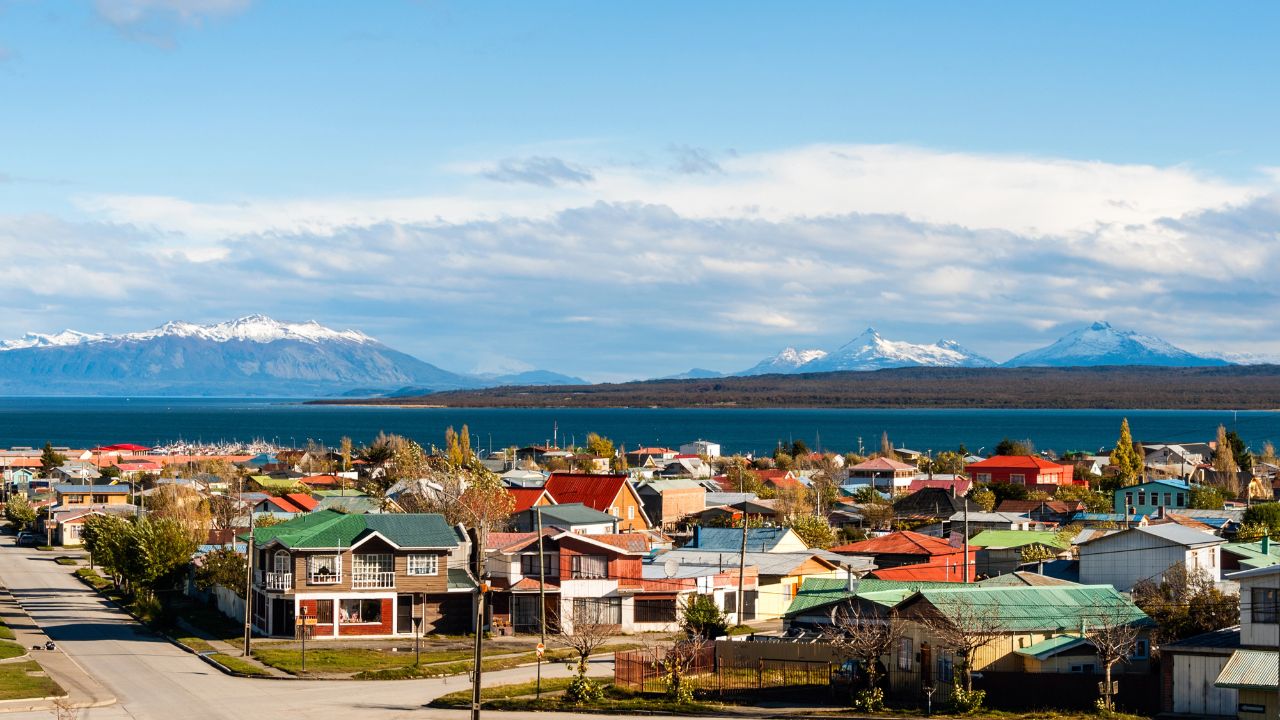
Puerto Natales, Chile
A quaint port town and convenient base for exploring Torres del Paine National Park, Puerto Natales, Chile captivates with its waterfront promenade, colorful houses, and rugged Patagonian scenery. The town’s cozy cafes and seafood restaurants offer a taste of local flavors and warm hospitality for travelers as they prepare to embark on any of the area’s beloved treks.
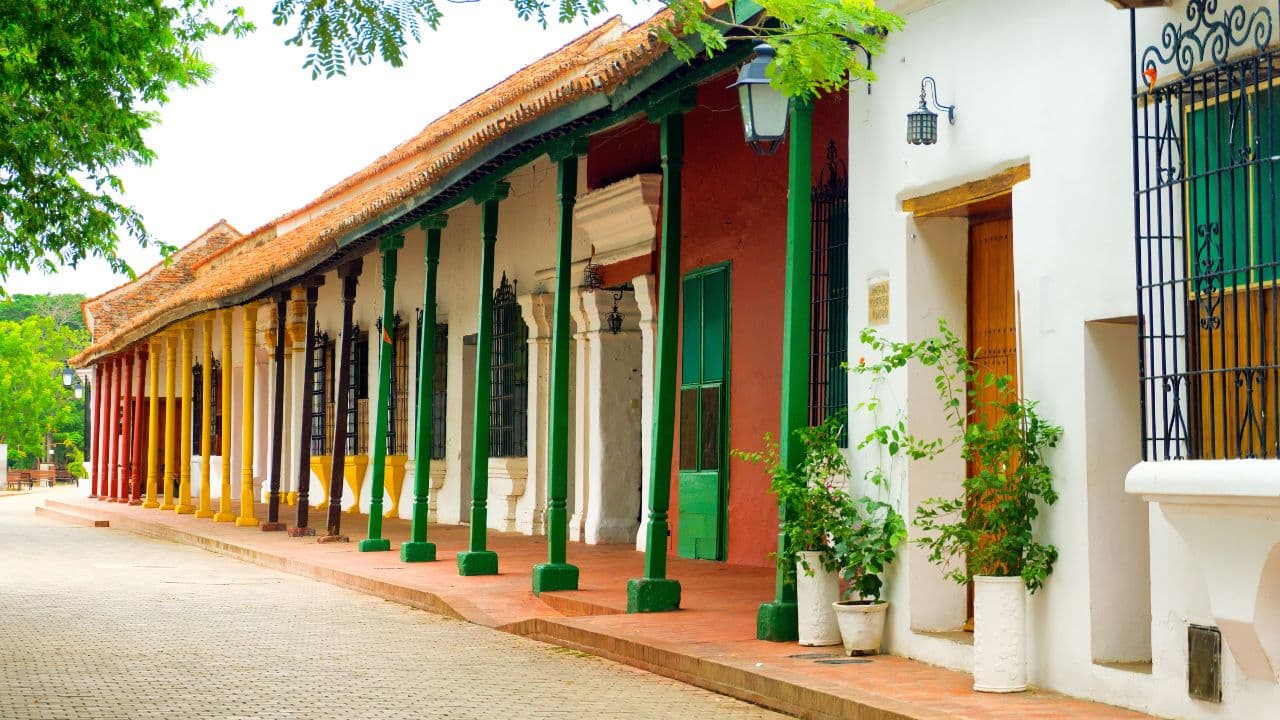
Mompox, Colombia
Time seems to stand still as horse-drawn carriages clatter along the cobblestone streets of Santa Cruz de Mompox, Colombia, known as one of the country’s most charming historic villages. Located along the banks of the Magdalena River, Mompox enchants with its well-preserved colonial architecture and small-town feel, having yet to draw too many visitors to overwhelm it with new development.
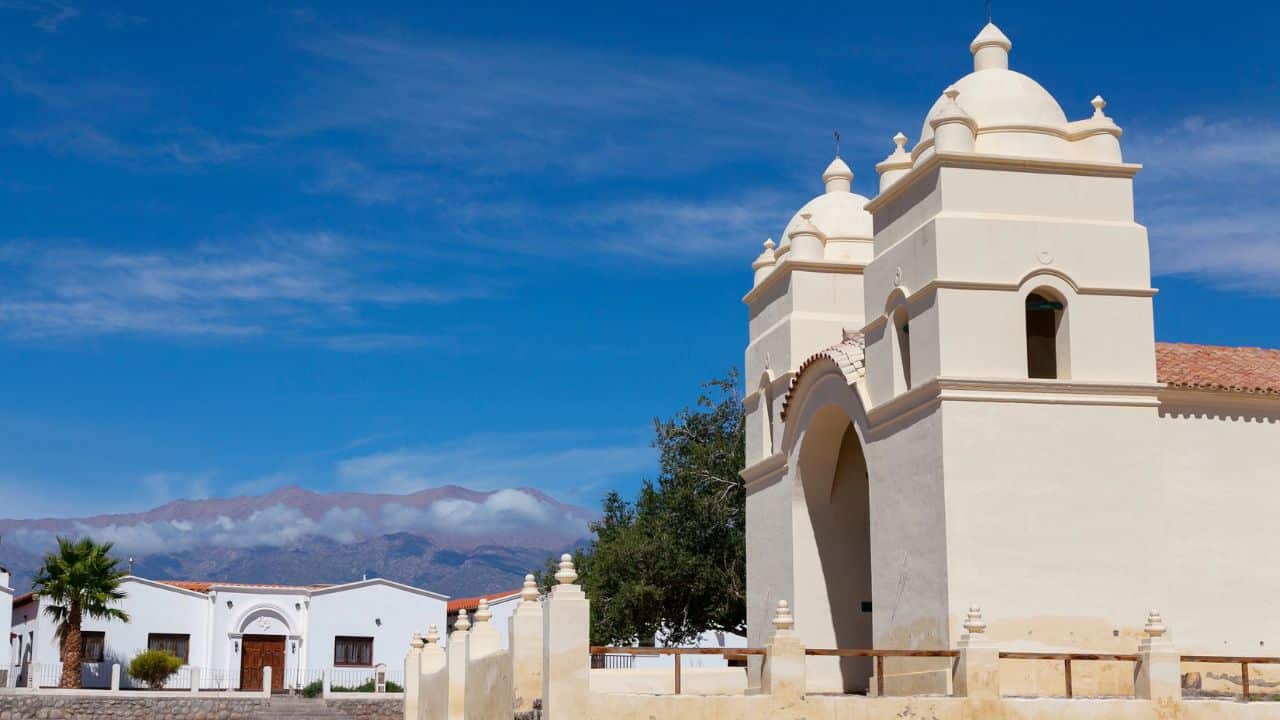
Cachi, Argentina
Nestled in the Calchaquí Valley, Cachi captivates with its adobe buildings, historic church, and breathtaking Andean landscapes, offering a serene escape in Argentina’s northwest. The town’s central plaza comes alive with bustling markets, where indigenous artisans sell their crafts and produce, while the surrounding mountains offer endless opportunities for outdoor adventures.
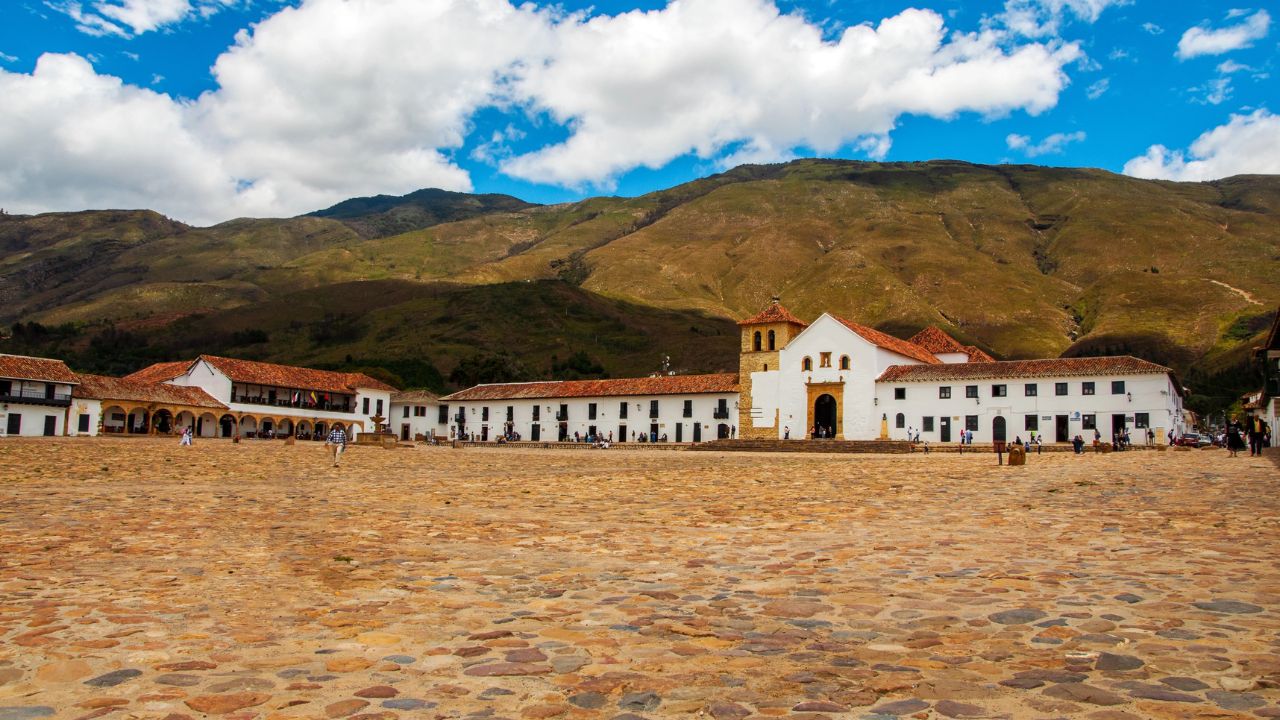
Villa de Leyva, Colombia
Villa de Leyva its wells know for hosting cultural events and festivals throughout the year like the renowned kite festival, adding to its vibrant allure and sense of community. Nestled in the Andean highlands, Villa de Leyva captivates with its well-preserved colonial center, bustling Plaza Mayor, and surrounding countryside dotted with fossils and vineyards.
More for You
45 Desserts from Around the World
Tornado forecast: NOAA issues 'high risk' alert for intense, long-track tornadoes
5 Types of Homes That Will Plummet in Value in 2024
Trump mocks Sen. Tester’s weight, hints at a Montana campaign appearance
25 of the Most Heroic Acts People Have Ever Witnessed
Phi Delta Theta member removed from Ole Miss fraternity after confrontation during campus protest
Garfield by Jim Davis
This humanoid robot currently holds the world record for speed
Chris Hemsworth and Elsa Pataky Dressed Like a Fairy-Tale Couple at the 2024 Met Gala
This Is The Thai Iced Tea We Can't Stop Making
40 Recipes That Will Make You Potluck Famous
Here's How Much Electricity It Takes to Charge A Tesla
The Minimum Salary You Need To Buy a Home in 2024 in All 50 States
Scientists discover 'missing' continent that had been seen for 375 years
New poll reveals a major warning sign for Biden and Democrats in key down-ballot races
I Cut My Food Expenses In Half Using The Viral "6-To-1" Grocery Method — Here's How
Beloved PGA Tour pro calls out LIV Golf players for excessive cursing at Masters
What Food Product Came Out the Year You Were Born?
Realtor Lists 3 Common Home Repairs That 'Ruin' People Financially
College president tells anti-Israel protesters they aren't entitled to 'take over the whole university'

COMMENTS
Rome2Rio makes travelling from Colombia to Ecuador easy. Rome2Rio is a door-to-door travel information and booking engine, helping you get to and from any location in the world. Find all the transport options for your trip from Colombia to Ecuador right here.
Travel Itinerary: From Colombia to Ecuador via Rumichaca Bridge. The whole journey with a budget per person: Day 1 / 8:00 pm Cali → Ipiales 6:00 am; Basic bus 65.000 COP ≈ €13. Day 2 / 6:30 am Ipiales → Rumichaca 6:40 am; Colectivo 2.500 COP ≈ €0.50. Day 2 / 7:40 am Exiting Colombia.
The bus ride takes 4 hours and costs $4. If you carry on to Quito, add another approximately 2 hours and $2. The bus was of good quality, be aware of thefts in the buses in Ecuador and never leave your hand luggage with valuables unattended.
Land Border Restrictions: All foreign citizens entering the country via land border crossings from Colombia or Peru are required to present an apostilled certificate showing a lack of criminal record. Further information is available on the Ministry of Tourism's webpage and at Ecuador.Travel. All U.S. citizens planning to enter Ecuador via a ...
The new requirements came into force at 00H00 on the 1 st December, 2021. ENTRY TO MAINLAND ECUADOR: All persons entering mainland Ecuador must present the following: A completed Traveler's Health Declaration form upon boarding the airline, this can be found at the following link: https://declaracionsalud-viajero.msp.gob.ec/.
While traveling through the Rumichaca Crossing from Colombia to Ecuador is generally safe, it's always important to take precautions to ensure a secure journey. Here are some safety tips to keep in mind: 1. Stay Informed: Stay updated on the current safety situation in both Colombia and Ecuador before your trip. Check travel advisories and ...
Land Border Restrictions: All foreign citizens entering the country via land border crossings from Colombia or Peru are required to present an apostilled certificate showing a lack of criminal record. Further information is available on the Ministry of Tourism's webpage and at Ecuador.Travel. All U.S. citizens planning to enter Ecuador via a ...
Avianca - Aerovías del Continente Americano S.A. and LATAM Chile fly from Medellín to Quito every 4 hours. Alternatively, you can take a bus from Terminal de Transporte Norte bus station to Guayaquil via Pereira, Buga, Terminal de Transporte Cali, Terminal Ipiales, Rumichaca, and Terminal Terrestre de Guayaquil in around 29h 3m. Airlines.
Restaurants in Ecuador are open. Bars in Ecuador are . Find continuously updated travel restrictions for Ecuador such as border, vaccination, COVID-19 testing, and quarantine requirements.
Colombia to Ecuador by bus quick summary. To help you better for your trip, below is a summary of my travel from Colombia to Ecuador: Start in Cali, Colombia. It is easier to get to Ecuador through this city. From Cali, take a bus to Pasto. This will take 10 hours and will cost you COP40,000 ($20).
Location: Nationwide. Event: Due to ongoing security concerns, the U.S. Department of State has updated the Travel Advisory for Ecuador to include the canton of Duran, located in the province of Guayas, in the list of Level 4 - Do Not Travel regions. The updated Travel Advisory also includes information for U.S. citizens about the ongoing state of emergency in Ecuador, which is also ...
The bus from Mindo to Quito leaves three times a day, but you need to get the earliest possible bus if you're planning to cross the border to Colombia that same day. The Flor del Valle bus from Mindo to Quito leaves at 6:30am and costs $3.60 USD per person. The journey takes 2-2.5 hours. Cost: $3.60 USD per person.
The cheapest flight deals from Colombia to Ecuador. Guayaquil.$234 per passenger.Departing Tue, May 28, returning Mon, Jun 3.Round-trip flight with Avianca.Outbound indirect flight with Avianca, departing from Cartagena on Tue, May 28, arriving in Guayaquil.Inbound indirect flight with Avianca, departing from Guayaquil on Mon, Jun 3, arriving ...
The cheapest flight deals from Colombia to Ecuador. Guayaquil. £184 per passenger.Departing Wed, 26 Jun, returning Tue, 2 Jul.Return flight with Copa.Outbound indirect flight with Copa, departs from Cartagena on Wed, 26 Jun, arriving in Guayaquil.Inbound indirect flight with Copa, departs from Guayaquil on Tue, 2 Jul, arriving in Cartagena ...
The most common border crossing route is to take the bus from Quito to Tulcan, cross at Rumichaca - and then travel onwards from Ipiales to Pasto or Popayan in Colombia. This route can be done in a single day and involves at least four taxis and two buses, and takes 8-9 hours in total if your first night in Colombia will be spent in Pasto or 16 ...
There is also the regrettable and exaggerated reputation surrounding the safety of the Ecuador-Colombia border, considering Colombia's history of conflict. In actuality, the myths are so dissimilar to the truth that they are nonsensical. The only way to get into trouble is to do one of two things: 1) seek out trouble, or 2) stray too far from ...
Greetings from Quito, Ecuador!We are so happy to be resuming our year-1 travel plan since the protests in Peru threw a monkey wrench into our itinerary. Needless to say, crossing the Colombia-Ecuador border on foot to get to Quito was not part of the plan!. We were supposed to arrive in Quito, Ecuador like most travelers do - by plane.But we were forced to leave Peru 1 month earlier than ...
You can travel to Ecuador for up to 90 days in any 12-month period without a visa. ... If you enter Ecuador via land from Peru or Colombia, you must get an official passport entry stamp showing ...
Call us in Washington, D.C. at 1-888-407-4747 (toll-free in the United States and Canada) or 1-202-501-4444 (from all other countries) from 8:00 a.m. to 8:00 p.m., Eastern Standard Time, Monday through Friday (except U.S. federal holidays). See the State Department's travel website for the Worldwide Caution and Travel Advisories.
You can take a bus from Terminal de Transporte Cali to Terminal Terrestre Quitumbe via Terminal Ipiales and Rumichaca in around 15h 57m. Alternatively, Avianca - Aerovías del Continente Americano S.A., LATAM Chile, and Copa Airlines fly from Cali (CLO) to Quito (UIO) every 4 hours. Airlines. Avianca - Aerovías del Continente Americano S.A.
Many of the backpacking routes across South America hit the biggest cities in the region's most popular destinations, including cities like Medellin in Colombia, Buenos Aires in Argentina, and ...
Find the travel option that best suits you. The cheapest way to get from Quito to Colombia costs only $69, and the quickest way takes just 4¾ hours. Find the travel option that best suits you. ... Ecuador and Colombia? Avianca - Aerovías del Continente Americano S.A. and LATAM Chile fly from Quito to Medellín 4 times a day. Alternatively ...